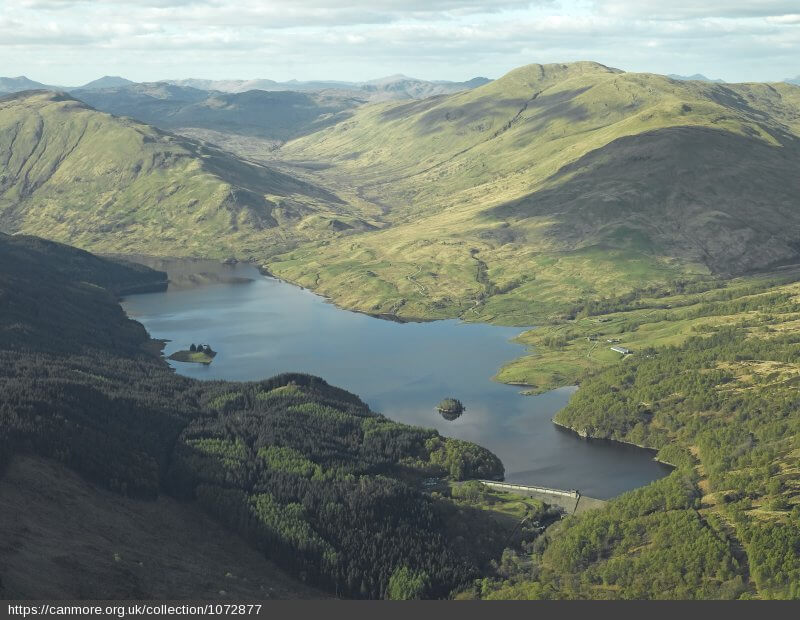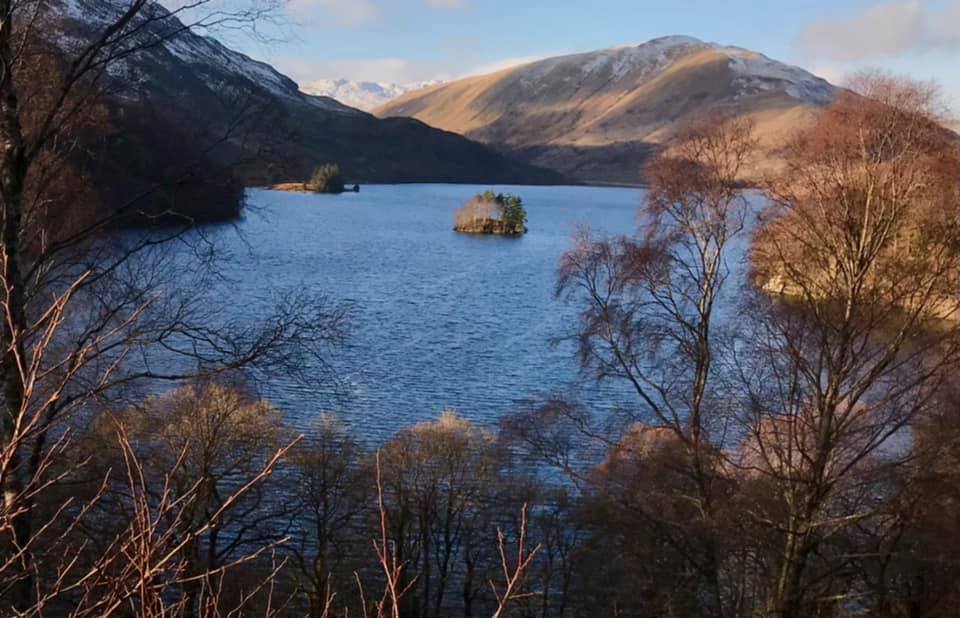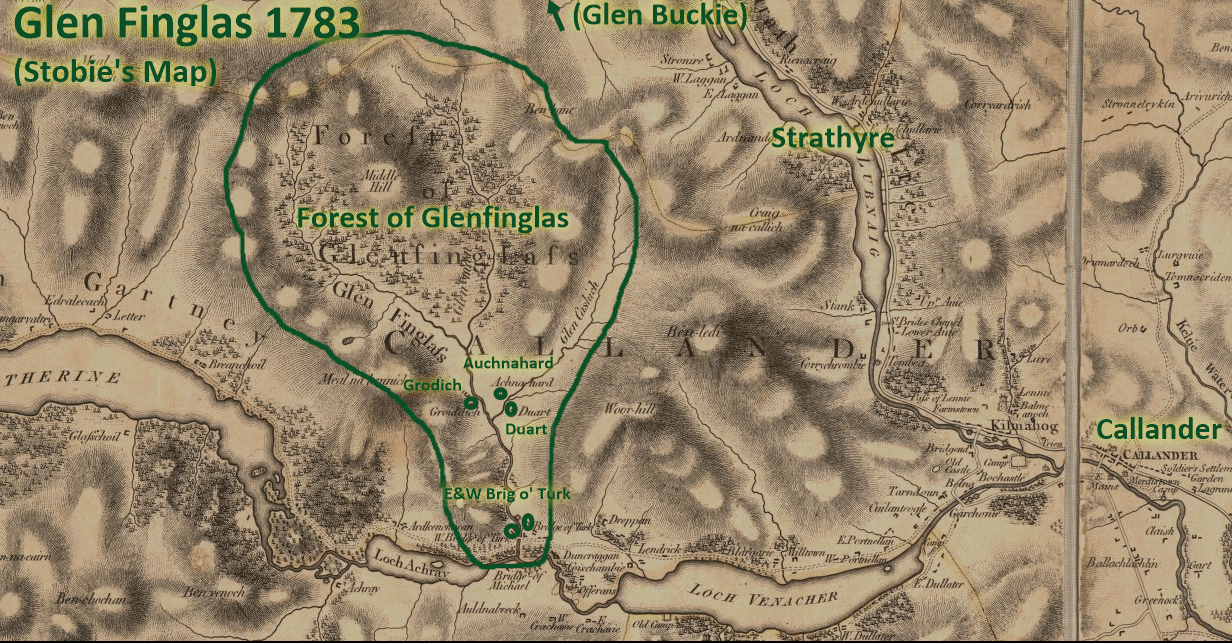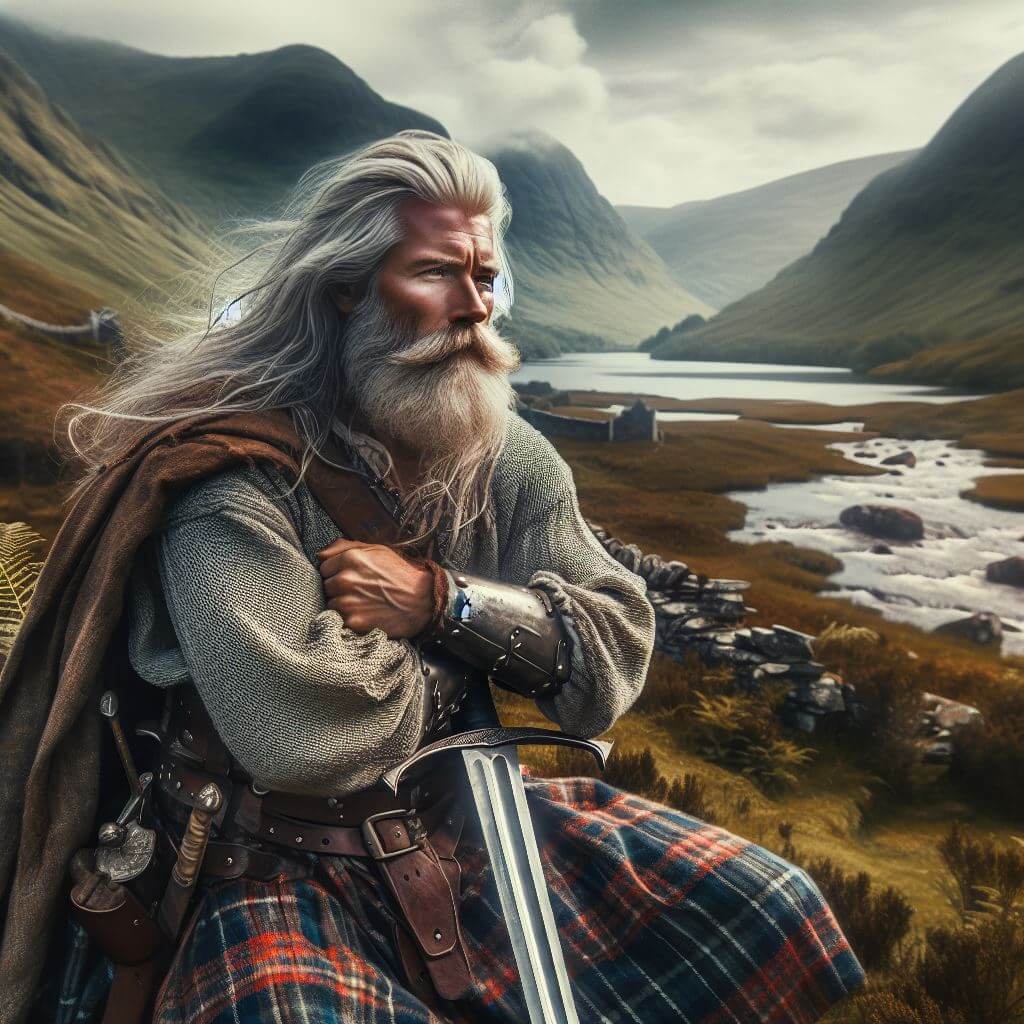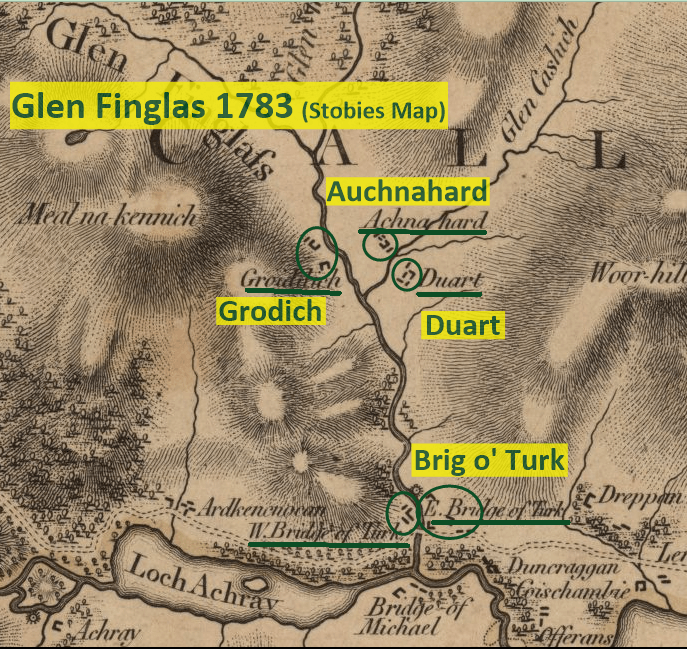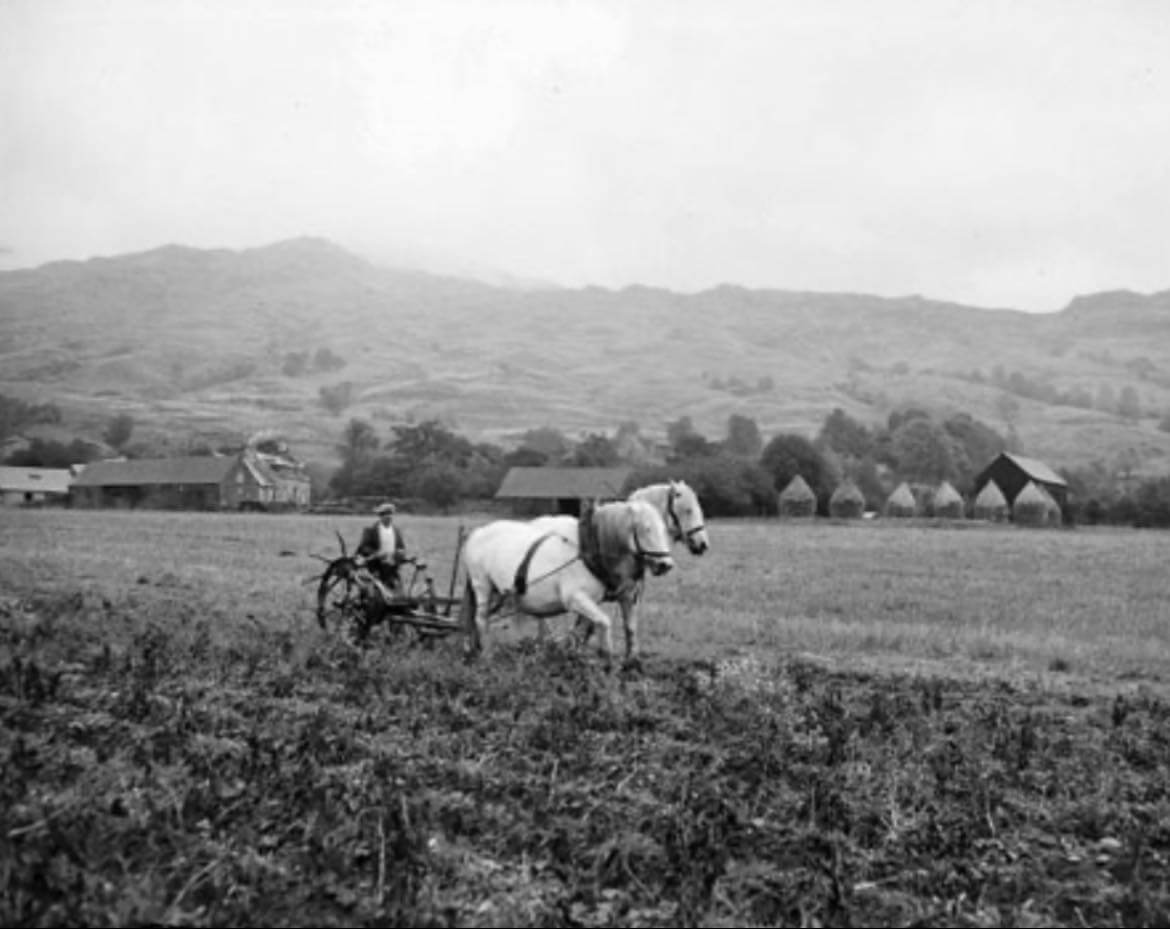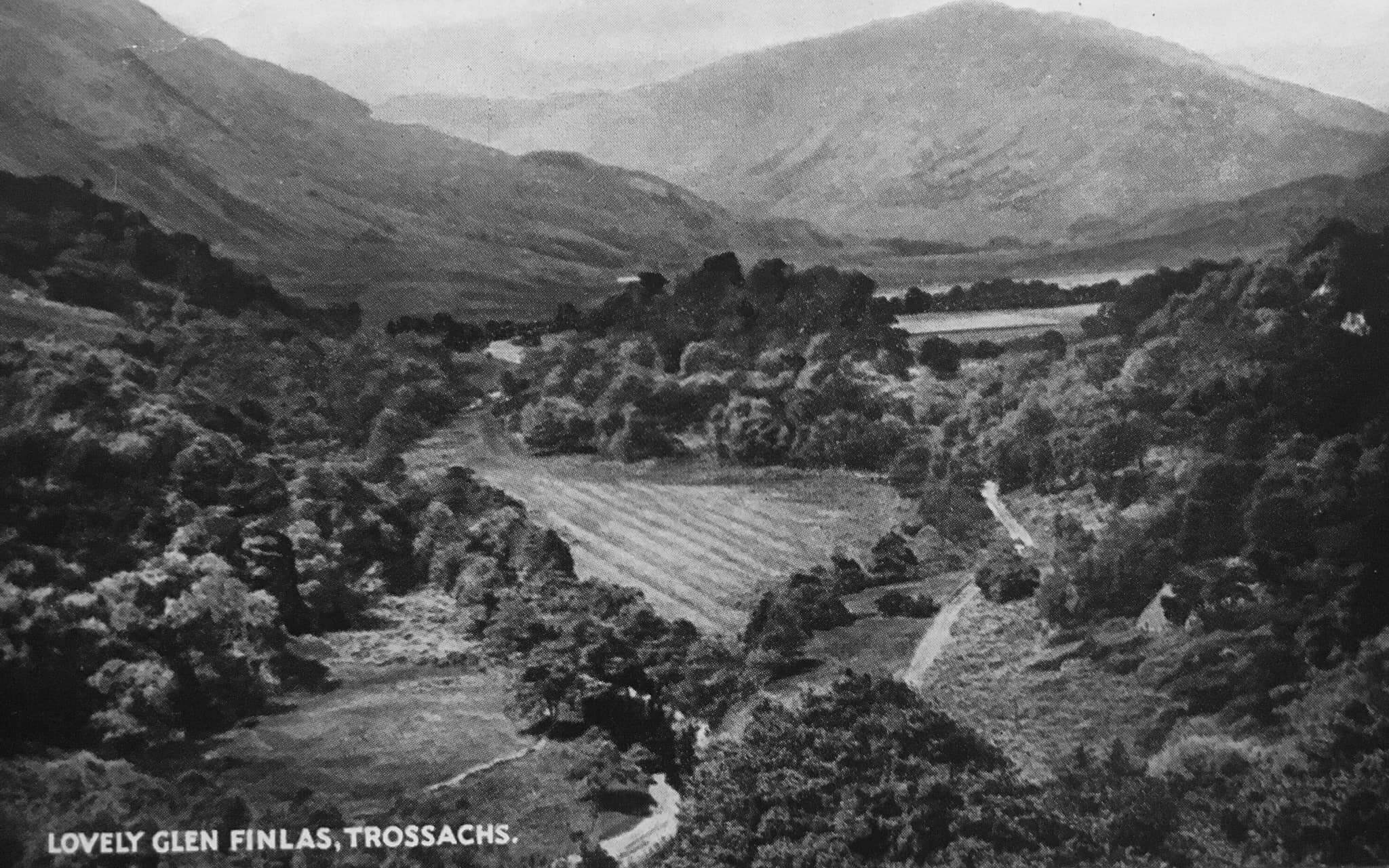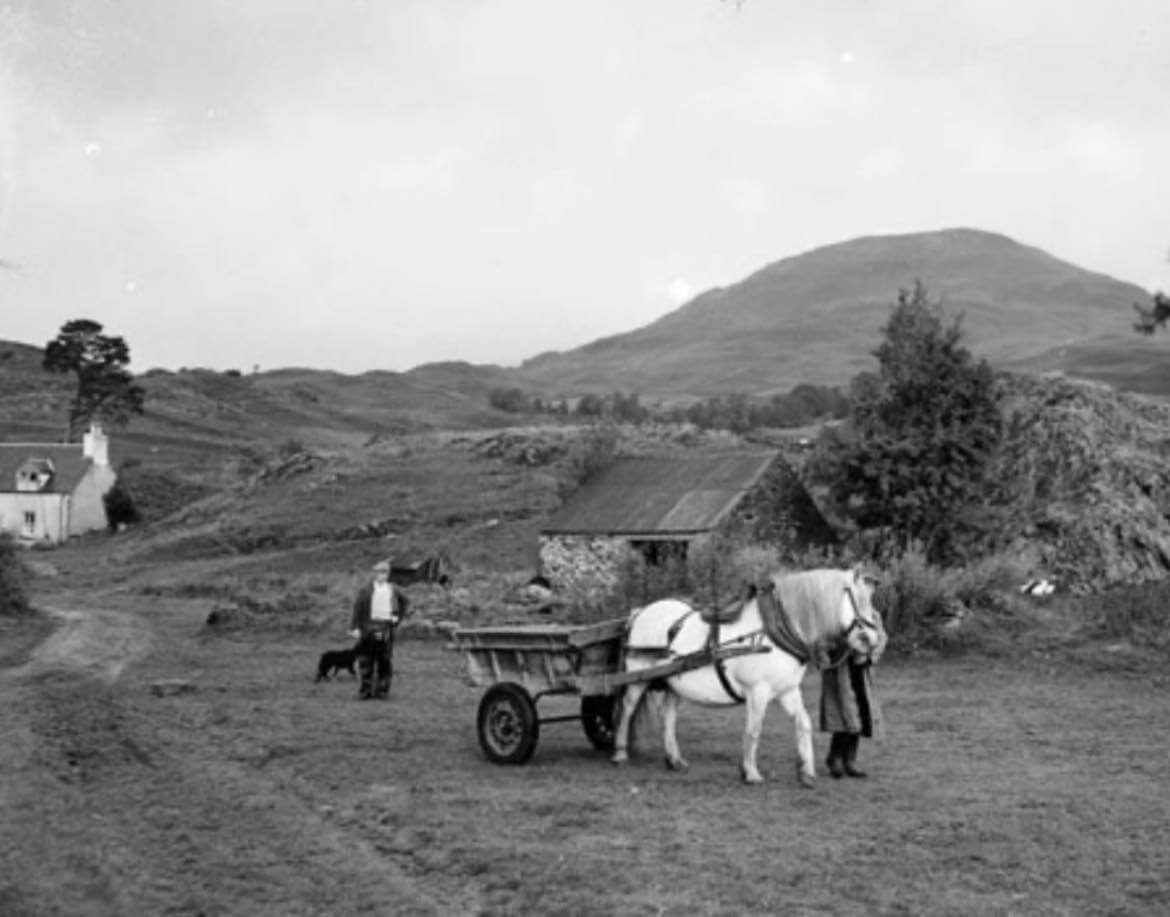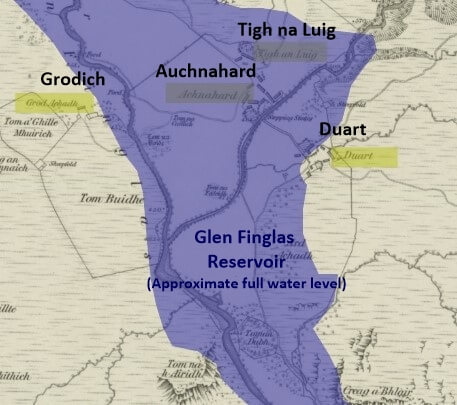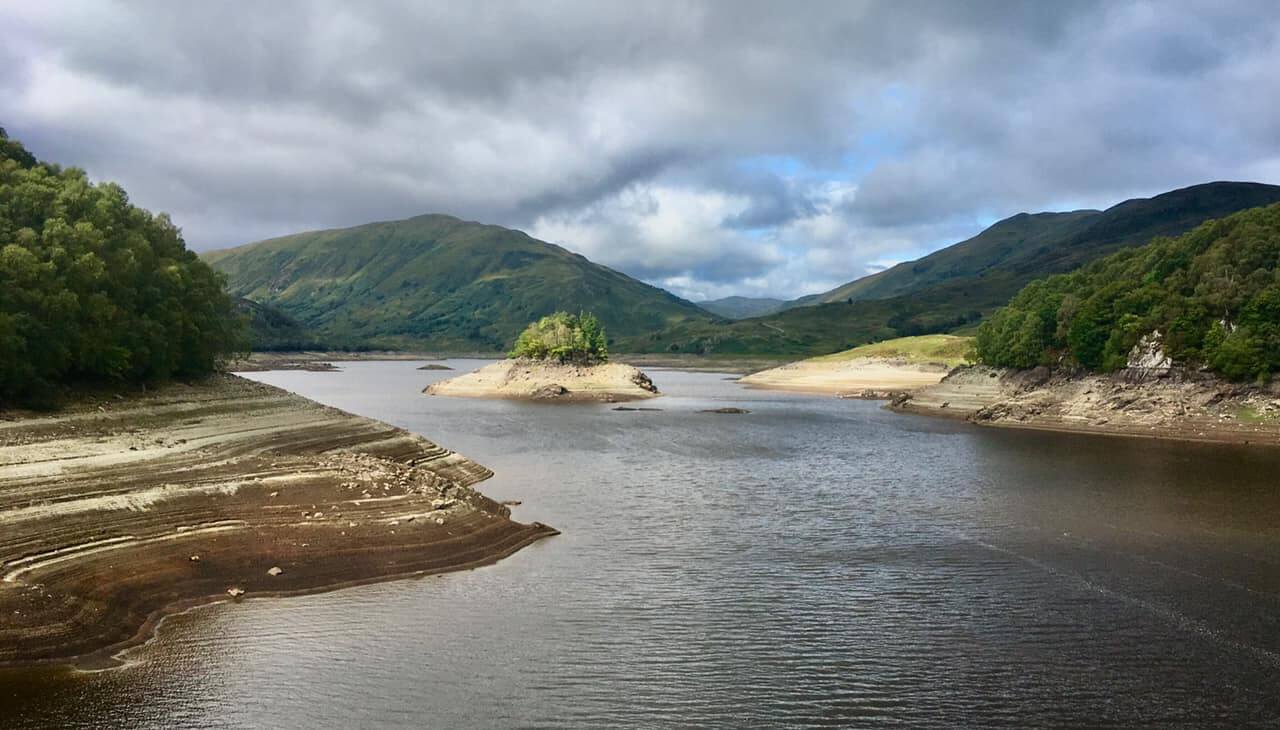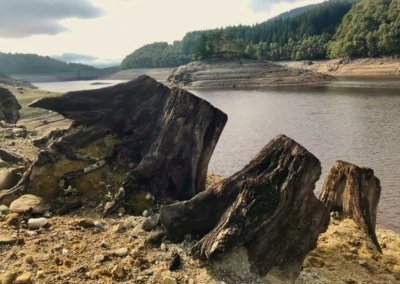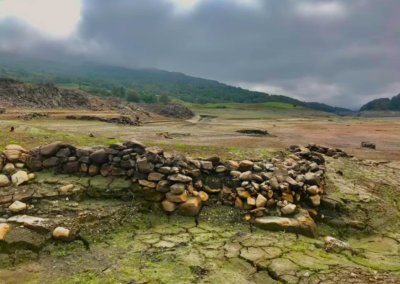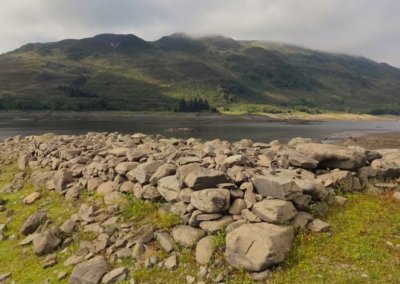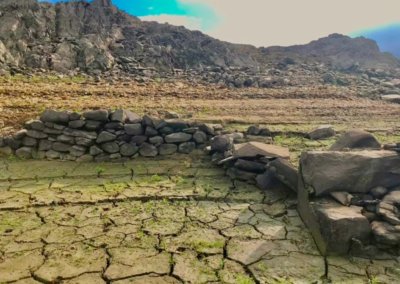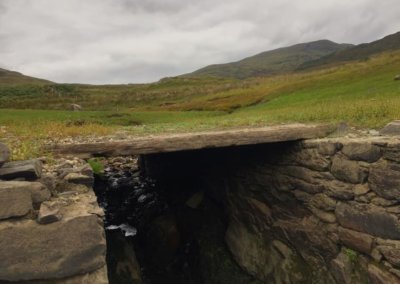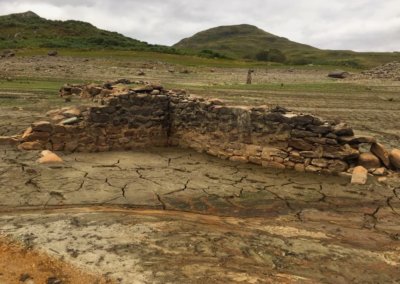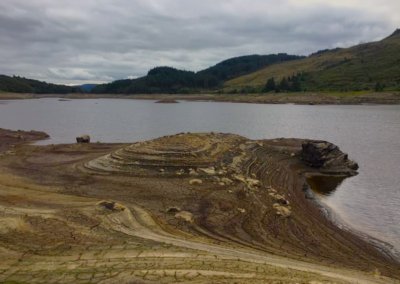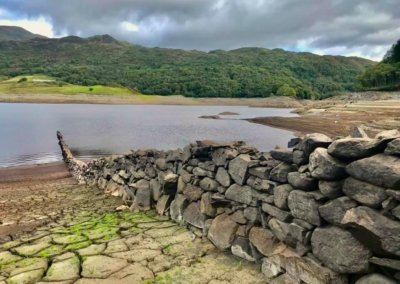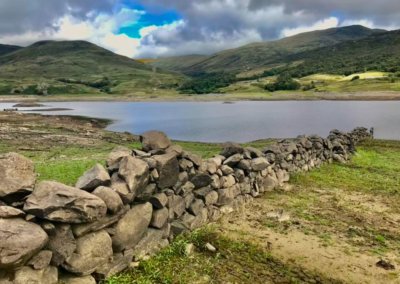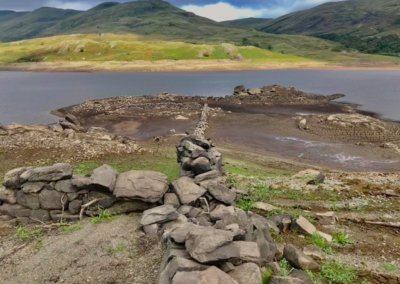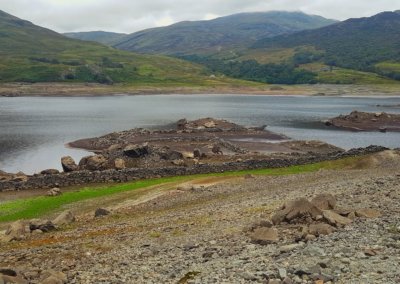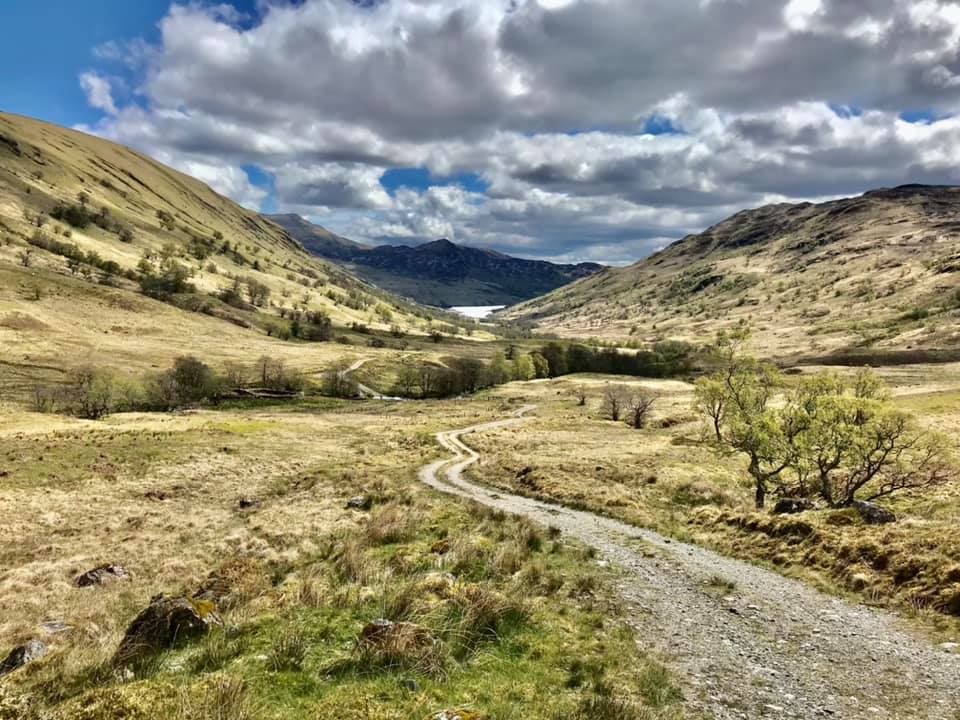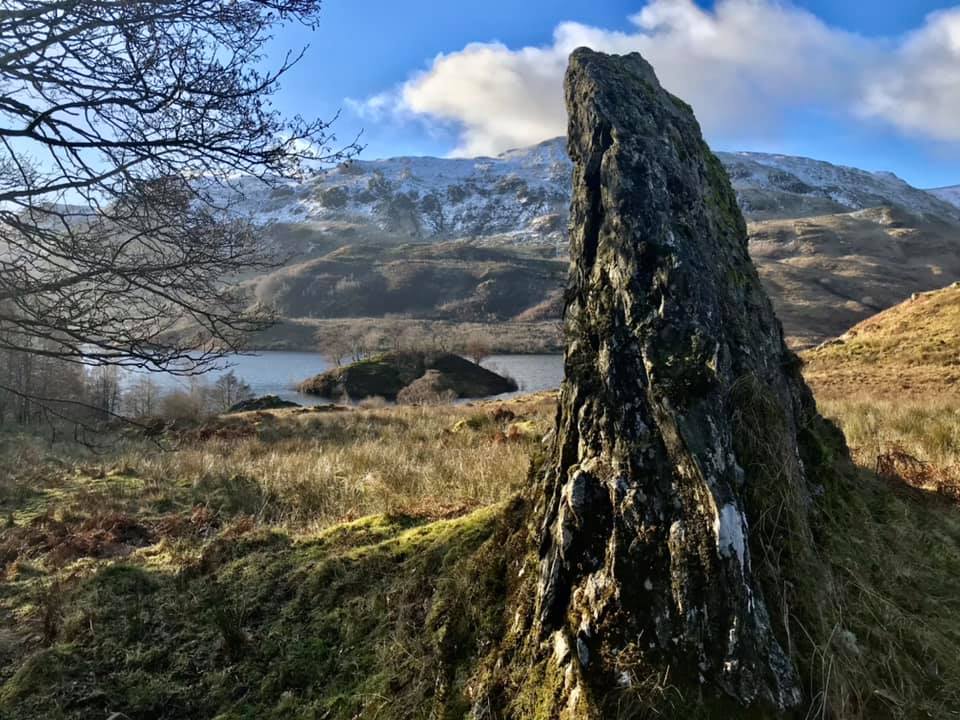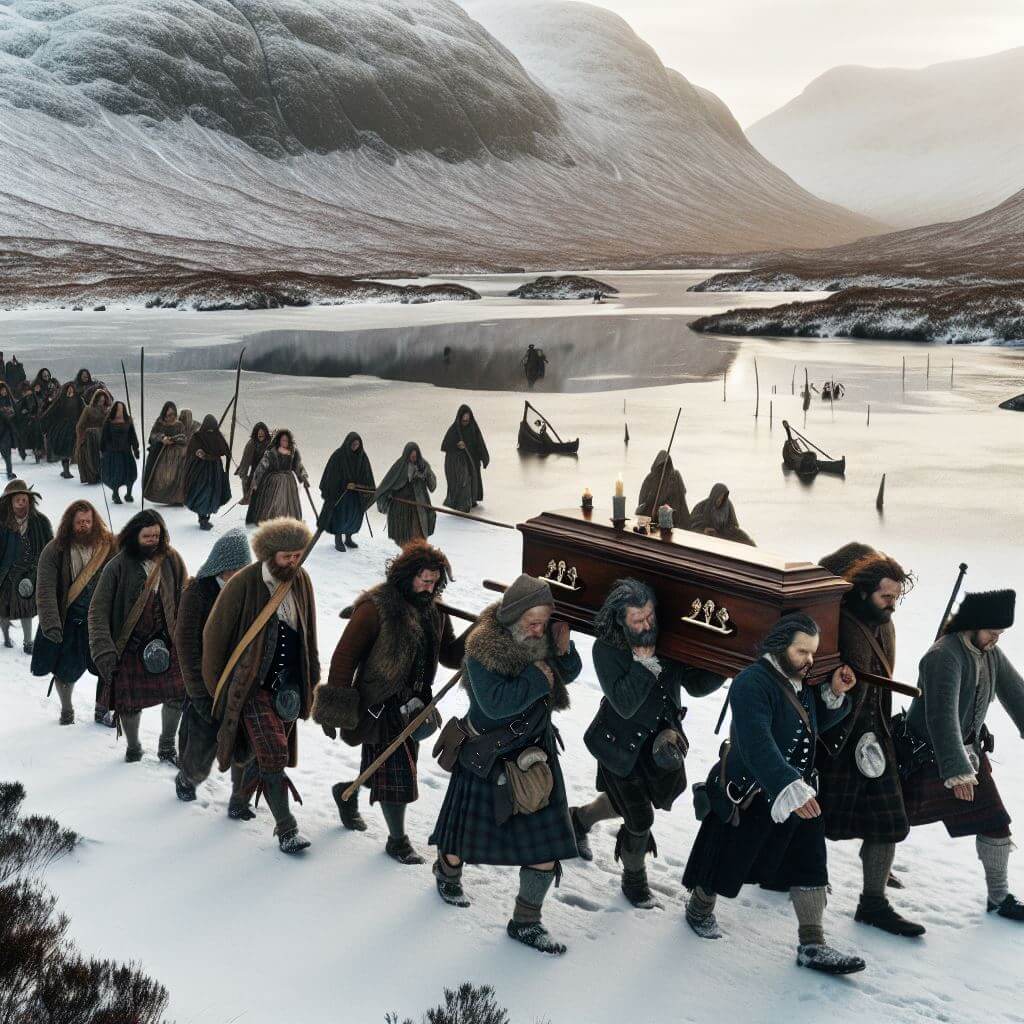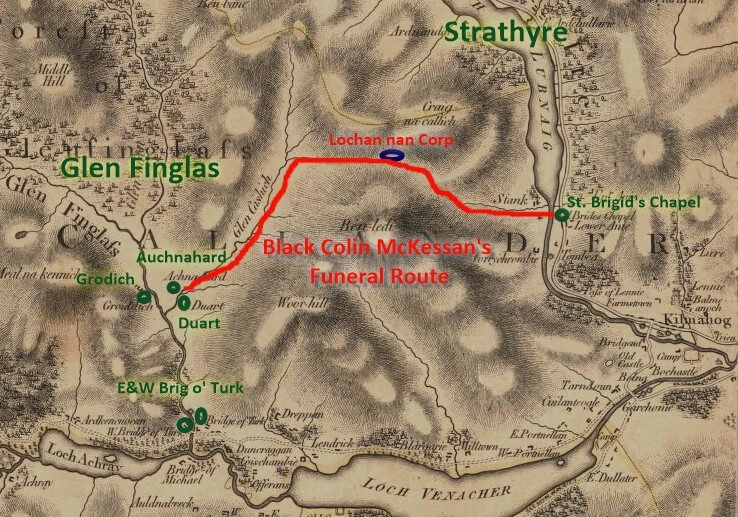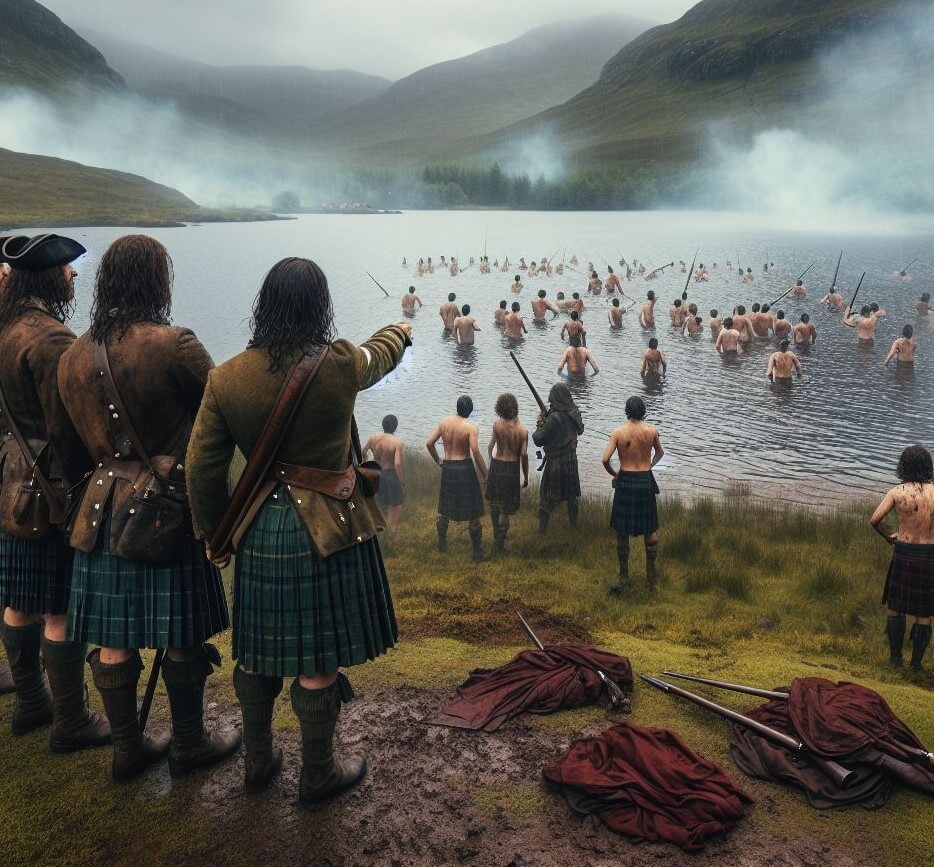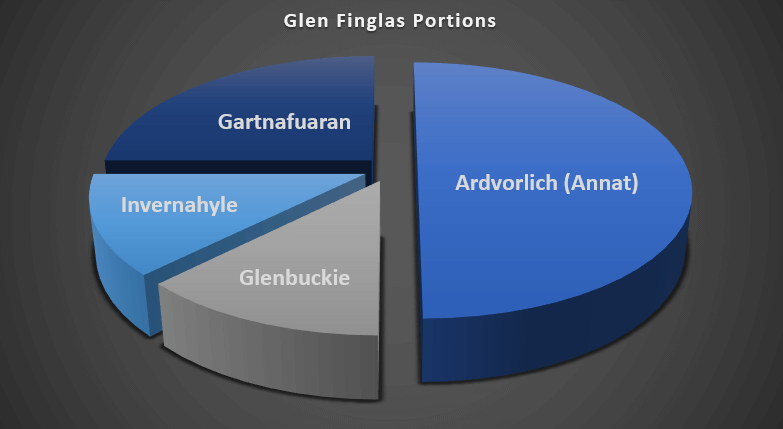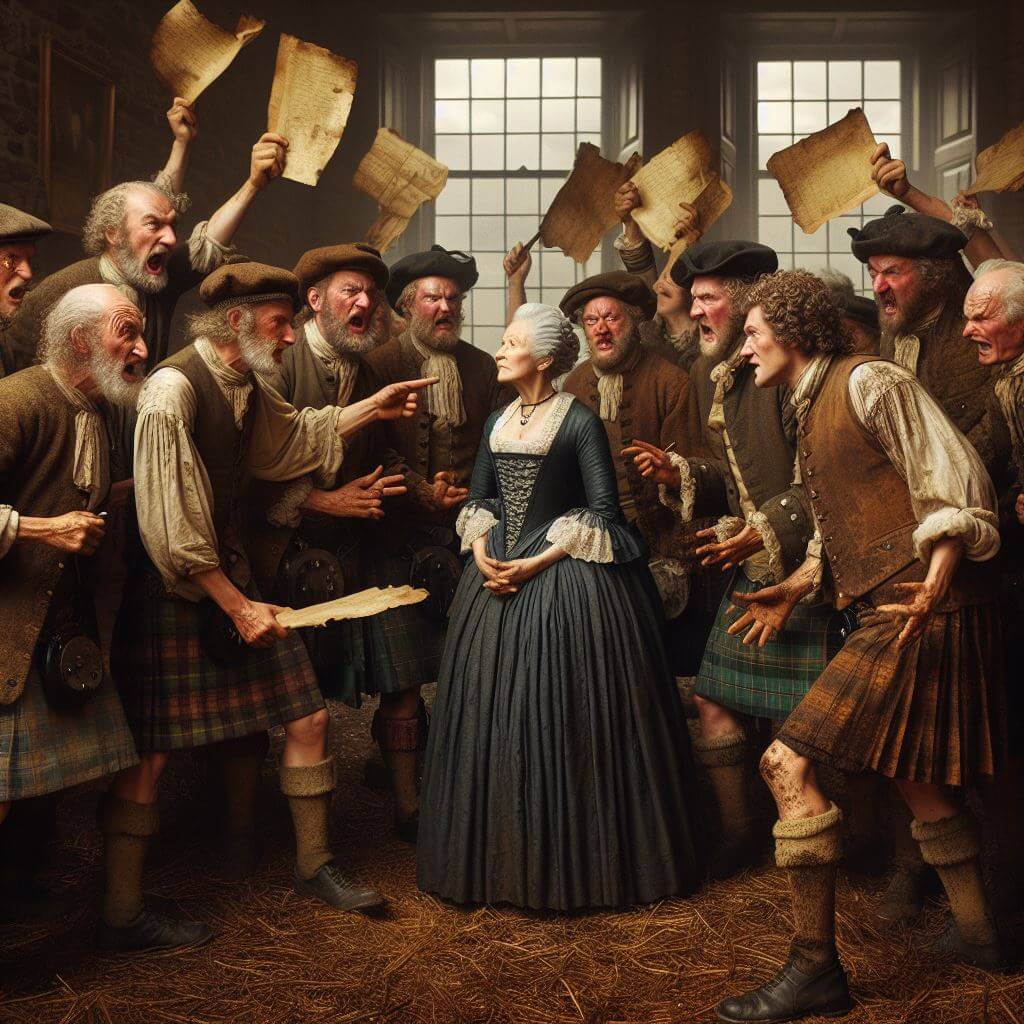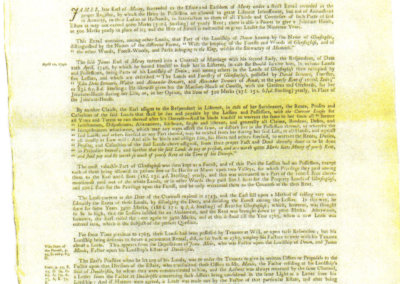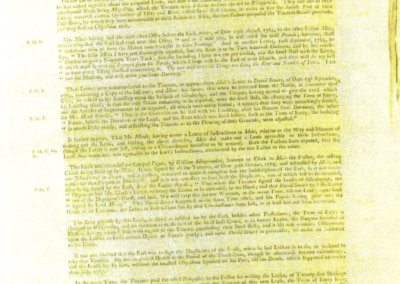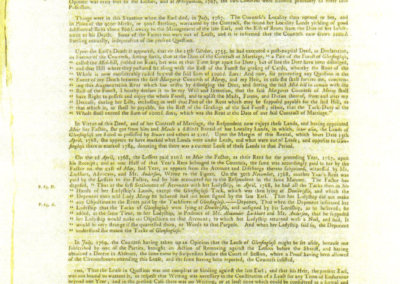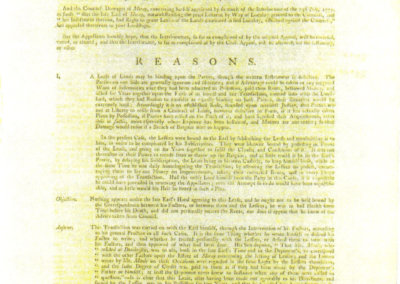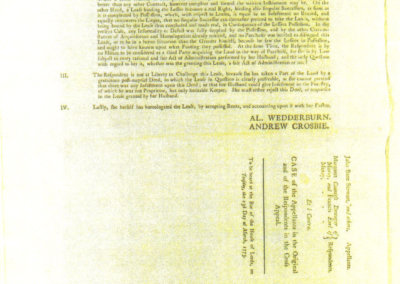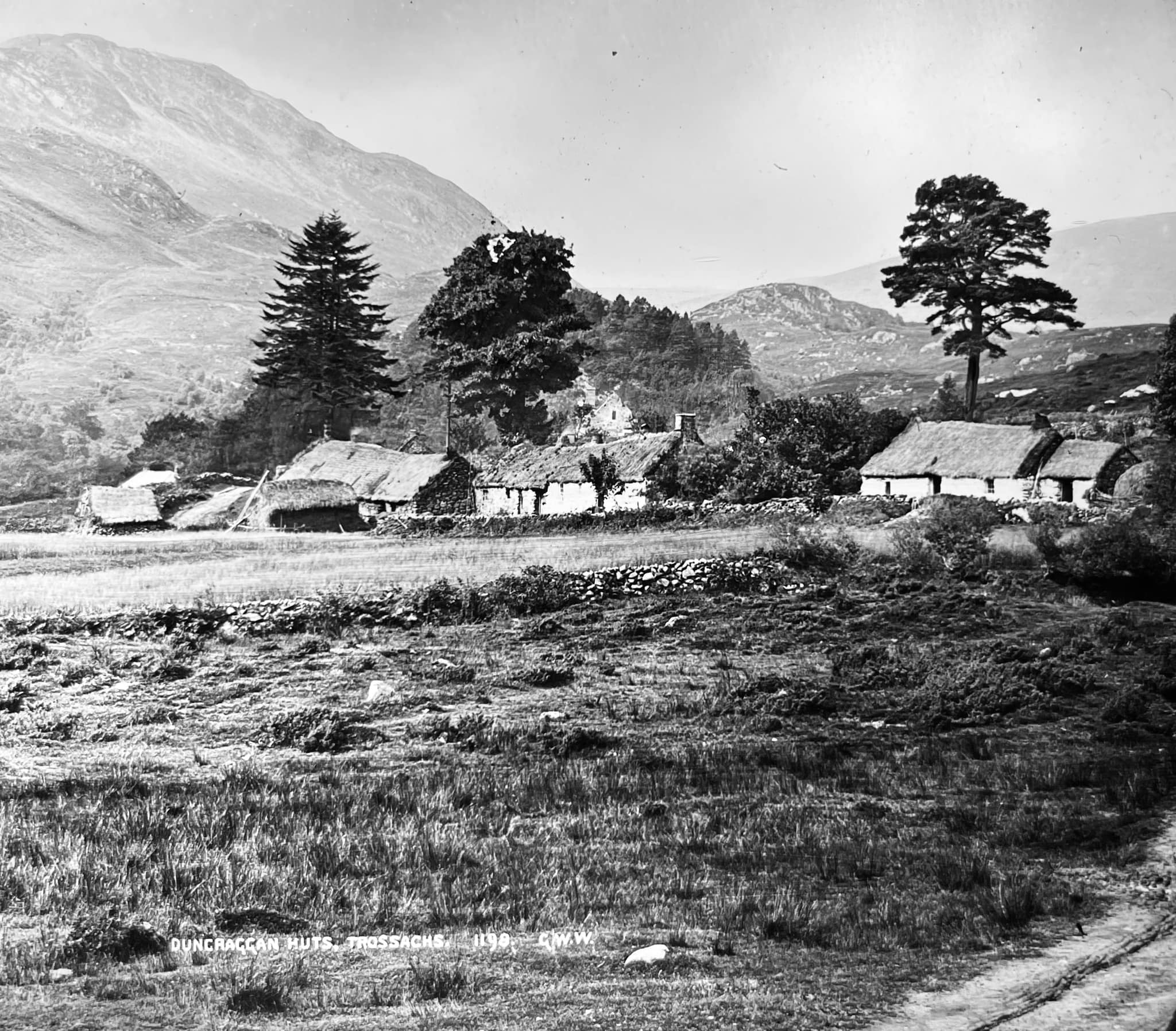The Stewarts in Glen Finglas, Callander, Historic Perthshire, Scotland
Various families from the Stewarts of Balquhidder and the Stewarts of Appin
This is the story of the Stewarts in Glen Finglas.
Glen Finglas is a beautiful glen on the southern edge of the Highlands in Scotland in the former historic county of Perthshire. In 2002, its lands were incorporated into the Loch Lommond and Trossachs National Park. In 1965, the glen was dammed up to create a large reservoir to supply drinking water for the city of Glasgow. The reservoir loch now sits as the centerpiece of the glen. Prior to the dam being built, the glen was fertile forest and farmland.
in the 17th-19th century, Glen Finglas was a bustling glen with four large farming townships populated almost entirely by Stewart families. But how did all these Stewarts in Glen Finglas come to replace the former native inhabitants? And who were these Stewarts in Glen Finglas? Where did they come from? How were they related?
In the early 16th century, Glen Finglas was a Royal hunting ground primarily occupied by the McKessan clan and other local clans, including McKinlays and MacGregors. Around the year 1600, Clan McKessan were almost completely wiped out when a funeral procession fell through the ice of a nearby loch and most of the clan drowned. Local legend tells us that some nearby MacGregor caterans, having been deprived of their own lands, invaded the vacated glen and forcefully occupied the abandoned McKessan homes. These MacGregors allegedly required to be removed by Maj. James Beag Stewart, 2nd of Ardvorlich, chief of the nearby Stewarts of Balquhidder, and replaced with more peaceful tenants, namely Stewarts. The descendants of these Stewart families remained in Glen Finglas occupying the farming settlements of Auchnahard, Grodich, Duart, and Brig o’ Turk until the late 19th century when the glen was mostly abandoned due to emigration. All the residences but Brig o’ Turk are now submerged under the waters of Glen Finglas Reservoir.
Here, we will explore the history of Glen Finglas and the Stewart families who occupied it from the early 17th century to the end of the 19th century.
Glen Finglas (c/o Canmore.org.uk)
Glen Finglas in Autumn by Siuna Mayes
Note: The following video was recorded before we learned the identity of the funeral party who perished in Lochan nan Corp and incorrectly identifies them as McKinlays instead of McKessans.
Glen Finglas
The Glen of the White Stream or the Glen of Finlay the Grey?
Glen Finglas lies at the heart of the Loch Lomond and the Trossachs National Park and is part of the Great Trossachs Forest National Nature Reserve. Glen Finglas is located in Callander parish, northwest of Loch Venachar and south of Glen Buckie, in the former historic county of Perthshire, Scotland (part of the present-day Stirling Council Area). Prior to the late 20th century it was a thriving glen of good farmland and forest, rich with inhabitants and history.
We first start to see mention of Glen Finglas in historical records when the glen became a royal hunting forest for King David II and his successors.
“Glen Finglas was possibly the most popular of all royal hunting forests. David II, Robert II, James I, II, III, IV and V and many important Scottish Earls hunted here. In particular, James II built a permanent hunting lodge in the glen.”
(Glen Finglas Woodland Trust)
King David II, who lived and reigned in mid-14th century, was the earliest monarch we know of who used Glen Finglas as a royal hunting ground, but that does not mean that it was uninhabited. It contained several farming crofts populated by local clans dominated by Clan McKessan, Clan McKinlay and others. They would not have been permitted to hunt in its royal forests, but they could farm the land. Today, Glen Finglas is nearly vacant of inhabitants, having been dammed up and flooded in 1965 to provide water for the city of Glasgow. The historic farm settlements discussed below are now under water.
History reveals its name: Its name reveals its history
How did Glen Finglas get its name? And can its name tell us something about its history?
From the time of Sir Walter Scott’s poem, Glenfinlas (1798), and throughout the 19th century, the name of the glen was most commonly rendered as “Glenfinlas.” Into the 20th century, it became consistently rendered as “Glen Finglas” with the added ‘g’. It is not the only glen in Scotland with this name. There is another Glenfinlas in Argyll just west of Loch Lommond which was the site of a famous 17th century battle between the MacGregors and the Calquhouns.
The name Glen Finglas is Gaelic in origin. As with many Scottish place names, exposure to centuries of Anglicization has made its exact derivation uncertain. Modern sources (including Wikipedia and many early 20th century travel gazetteers) suggest that the name derives from Gleann Fionn Ghlais, which means “Glen of the White Stream.” This could be correct, however earlier records reveal a different picture.
The earliest record of the name available to us comes from 1539 in which it is referred to as “the hunting of Glenfynlawis” in which the final element is distinctly three syllables: “fyn-la-wis.” This, as we’ll see, may hint at “Finlay” plus a suffix. In 1592, Duncan mac Alasdair Stewart was recorded as residing in “McGlenfinglas.” The patronymic prefix, “Mc” (meaning “son of”), suggests that name of the glen derives from a personal name, rather than a topographical feature. In 17th and 18th centuries, local Callander parish records sometimes refer to the glen as “Glenfinlayglas,” “Glenfinlayson,” and “Glenmacfinlay.” In each of these latter renderings, the first element is consistently given as “Finlay” suggesting that “Fin” may actually be an abbreviation of the personal name, “Finlay.” In Gaelic, these names would be rendered as Gleann Fionnlaigh Glas (“The Glen of Finlay the Grey”) or Gleann mac Fhionnlaigh (“The Glen of Finlay’s Son”). If we re-order the syllables of the 1592 rendering, “McGlenfinglas”, we get “Glenmacfinglas” which seems to be a combination of both “Glenmacfinlay” and “Glenfinlayglas.” These earlier versions of the name all seem to suggest that Glen Finglas was not named after a white stream, but was named after a person who was either “Finlay The Grey” or “the son of Finlay”.
Who was Finlay Glas (Finlay the Grey)?
But who was this eponymous Finlay Glas, or Finlay the Grey? Did he exist at all?
Finlay or Fionnlaigh is a popular Gaelic name derived from fionn laoch, meaning “fair hero.” The patronymic form of Finlay, mac Fhionnlaigh, when Anglicized, becomes “McKinley.” In the 16th century, there were McKinley families living in Glen Finglas, and to the north on the shore of Loch Earn in Balquhidder parish, as well as to the east in Strathyre where their traditional burial ground was located at The Anie.
Tantalizingly, there is a reference from 1589 of a Findlay Glas McIntyre* residing in Carnlia in Glen Beich on Loch Earn in Balquhidder parish just north of Glen Finglas. This Findlay Glas is described as the widow of Malcolm McDougal Ciar MacGregor. Malcolm MacGregor was chief of Clan Dougal Ciar in the late 16th century and lived initially at Inverlochlarig in Balquhidder, just north of Glen Finglas, then at Glengyle, just west of Glen Finglas, and finally at Auchnahard in Glen Finglas by 1619-1621. His wife’s name, Finlay, is normally a male name. It seems likely that Malcolm’s widow was not actually named Findlay, but was being identified by her father’s name and was probably “Daughter of FInlay Glas”, and her actual first name is unknown. Was Malcolm MacGregor’s father-in-law the Finlay Glas after whom Glen Finglas was named? Probably not. While the earliest record of the name Glen Finglas that we have found is from 1539, which would be contemporary with Malcolm McGregor’s father-in-law, there are secondary source mentions of the name going back to the time of King David II in the 14th century.
The legendary ancestor of the McKinlays in Strathyre was Finlay Glas Farquharson. Was he the Finlay Glas after whom the glen may have been named? Or was Finlay Glas perhaps an ancestor of the McKessans who lived in Glen Finglas in the 16th century?
We don’t know for certain who the eponymous Finlay Glas may have been or if he existed at all.
“Finlay the Grey”
(AI generated image by Bing Image Creator)
*Findlay Glas McIntyre
“In a decree of horning Feb. 15, 1589-90 ‘Tullibardin against his tenants,’ mention is made… of “Findlay glas McEantyre, Relict of umquhile Malcum McCoulcheir….” (Murray-MacGregor, Amelia, History of The Clan Gregor, 1898, Vol II, Ch. 18, p. 251.)
The Four Farm Townships of Glen Finglas
Glen Finglas included four farming communities: Auchnahard, Grodich, Duart and Brig o’ Turk. Three of these were submerged under water when the Glen Finglas dam was completed in 1965. The upper part of the glen, above the farmsteads, was a royal hunting reserve for centuries. The original farmsteads can be seen on older maps. A few photos survive of the last of the townships before the glen was flooded.
Glen Finglas Dam by Sarah Charlesworth
Auchnahard farm ca. 1950 (with Duart in the background).
The farmer is possibly John Cameron with his horses, Lady and Gypsy.
c/o Calander Heritage Society
Auchnahard & Tigh na Luig
Auchnahard derives from Achadh na-h’ard which means “field of the height.” It was the northernmost settlement in the glen and was located on the high ground above where the Finglas Water and Casaig Water converge.
It appears to have been the largest of the four farmsteads and was the primary residence of the Bain Stewarts in Glen Finglas who descend from John Ban Mor Stewart, after whom they are named. They were an illegitimate line descending from the Stewarts of Annat. Auchnahard was formerly located on the west side of the Allt Finglas before the river was dammed and the glen was flooded.
Auchnahard contained the lesser residence, Tigh na Luig (“House of the Hollow”).
Grodich (Glen Finglas Farm)
Grodich derives from Grod Achadh which means “ugly field.” It was located on steeper ground along the west bank of the Finglas Water. Grodich appears to have been the only one of the four residences that was not subdivided into smaller holdings.
Grodich was, at times, also known as the Glen Finglas (or Glen Finlas) Farm.
Glen Finglas – 1915 postcard. c/o Calander Heritage Society
Unknown farm in Glen Finglas ca. 1950. c/o Calander Heritage Society
Duart (Upper & Lower)
Duart derives from Dubh Ard which means “dark height.” It was divided into two smaller holdings: Upper and Lower Duart. We have not found a map that shows the locations of the separate holdings. Only the combined holding of Duart is shown on maps.
Duart was the primary residence of the Gartnafuaran and Invernahyle Stewarts who lived in Glen Finglas.
Brig o’ Turk (Easter & Wester)
At the mouth of the glen we find Brig o’ Turk. Its name derives from Brig an-Tuirc which means “Bridge of the Boars.” It was, and still is, divided into the separate settlements of Easter and Wester Brig o’ Turk. These former farmsteads are located at the mouth of Glen Finglas where the Finglas Water empties into the Dark Water on its way to Loch Venachar. The location of the dam creates the illusion that Brig o’ Turk is below and outside Glen Finglas. However, prior to the dam being built, it would have been the entrance to Glen Finglas.
The Brig o’ Turk settlements seem to have been primarily occupied by cadets of the Stewarts of Glenbuckie main branch. At the turn of the 18th century, we find Lt. Walter Stewart, son of Duncan Stewart, 8th Glenbuckie, described as a tacksman of Wester Brig o’ Turk and he was said to have had 1/8th of Glen Finglas.
Brig o’ Turk by EH Bailey, Atkinson Art Gallery Collection
Submerged and Temporarily Re-emerged
When the glen was dammed in the 1960s, three of the farming townships were submerged beneath the newly formed loch. In the summer of 2021, Scotland had very little rain. Drought conditions caused such a significant drop in water levels, that the ruins of these townships were briefly exposed and visible for the first time in 60 years. In the photos below you will see the ruins of the former farmsteads of Auchnahard and Grodich exposed to the naked eye. These ruins are now once again submerged beneath the waters of Glen Finglas Reservoir.
Approximate location of the Glen Finglas Reservoir covering the submerged former farmsteads.
Photo: Glen Finglas drained 2021, by Siuna Mays
The First Stewarts in Glen Finglas
In the Exchequer Rolls of 1502-1515, Sir William Stewart, 2nd of Baldorran and Balquhidder, and his eldest son, Walter Stewart, 3rd of Baldorran and Balquhidder, are listed as Crown tenants in the lands of Estir and Westir Duchraa (also known as Innerquhawawane and Glenmaan) and Blarbaith. These lands are described as forming “part of Glenfinglas” (The Stewarts of Ardvorlich, Book III, p. 42f). Glenmaan is Glean nam Meann, which lands encompass the sheiling lands north of Glen Finglas and south of Glen Buckie.
Stewarts of the South devotes a section to the Stewarts in Glen Finglas. The author begins:
A mention shall be made often in the course of this narrative of Glenfinglas. Before I proceed further I shall lay before you a part of the history thereof. I think it was about the year 1535 or 6 that James Stewart of Beith or Lord Doun (sic – it was the son of this James Stewart who became Lord Doune) first got possession of this glen as Steward of Menteith – but before that time it was occupied by a numerous family or tribe of Clan Resans (sic, s/b Clan Kesans – this is a transcription error). But that tribe were almost lost except some old men and children in crossing the hill from Glenfinglas to an adjacent part of the parish of Callander with a burial in winter by coming unawares upon a small lake where the ice gave way and they were all drowned.
The high road in upper Glen Finglas, by Siuna Mayes
Glen Finglas, by Siuna Mayes
Sir James Stewart of Beath/Beith, Constable of Doune Castle
Sir James Stewart of Beath/Beith, Constable of Doune Castle
Sir James Stewart of Beith was a son of Andrew Stewart, 2nd Lord Avandale, who was a son of Alexander Stewart, 1st Lord Avandale, who was a son of Walter Stewart, Baron of Morphie, who was a son of Sir Walter Stewart of Lennox, who was brother to James Mhor Stewart of Albany, progenitor of the Stewarts of Baldorran and Balquhidder, ancestor of the Glenfinglas Stewarts. Thus James Stewart of Beith was a fourth cousin to James Stewart in Balquhidder, last of the Baldorran Family.
Sir James Stewart of Beith was the brother of Henry Stewart, 1st Lord Methven, who married Margaret Tudor, widow of King James IV (and sister of the English King Henry VIII). As Queen of Scotland, Doune Castle became Margaret’s residence. Doune Castle had previously been the possession of the Albany Stewarts, ancestors of the Baldorran (Balquhidder) and Beith Stewarts.
In 1528, Margaret Tudor appointed her brother-in-law, Sir James Stewart of Beith, as constable of Doune Castle. He died in 1547 and was succeeded by his son, James Stewart, who was created 1st Lord Doune in 1580 by King James VI and whose son, James Stewart, became 2nd Earl of Moray by marriage to Elizabeth Stewart, Countess of Moray, daughter of James Stewart, 1st Earl of Moray. Thus, by this circuitous route, Doune Castle returned to the descendants of the same family who had previously been forfeit.
(There are enough James Stewarts above to confuse even the most careful reader.)
The Stewarts of Ardvorlich, Book III, also mentions that the first Stewart to be associated with Glen Finglas was James Stewart of Beith (father of the 1st Lord Doune) who was given possession of Glen Finglas as Steward for the Earl of Menteith. He was ancestor to the later Stewart Earls of Moray who were the landlords of Glenfinglas. James Stewart of Beith did not actually reside in Glenfinglas but was merely the laird. He is described below in more detail than what might seem necessary at first. However the detail reveals the nature of the very close relationship between the families of Stewarts who occupied Glenfinglas and the family of Stewarts who were their landlords.
The Stewarts of Ardvorlich, Book III, also indicates that “the first person of the name of Stewart actually settled in Glenfinglas, was James Stewart in Glen, who is mentioned in 1575 in the special Retour of James Stewart of Baldofran (Baldorran) in the lands of Emyrcrethan and Croftintarry (Easter and Wester Cregan in Strathyre).” The most likely candidate for this James would be James Stewart, son of Alexander Stewart, 4th of Glenbuckie, who is believed to have had no descendants.
In 1580 Duncan Stewart, son of Black Alexander of Glenbuckie, 4th of Glenbuckie, was appointed as Deputy Royal Forester in Glenfinglas.
In 1592, Alexander Stewart, 1st of Ardvorlich, conducted a cattle raid into Dryman in Stirlingshire. Court records list one of his accomplices as Duncan M’Alister Stewart in McGlenfinglas. The late John Stewart of Ardvorlich, in The Stewarts of Ardvorlich, incorrectly identified this Duncan Mcallaster Steuart as being the son of Alexander Stewart, 1st of Ardvorlich, however that Duncan wasn’t yet born. It was more likely Duncan Stewart, son of Black Alexander Stewart, 4th of Glenbuckie, Forester in Glen Finglas.
Lochan nan Corp
The Tragic Extinction of the Kessanach
And the Vacancy of Glen Finglas
Glen Finglas and St. Bride’s Chapel at the Anie in Strathyre are joined overland by an ancient coffin road, known as Bealach nan Corp (“Road of the Dead”) which passed by a very small lake, called Lochan nan Corp (“little lake of the dead/corpses/bodies”). The road continues down the Stank Glen on the west side of Strathyre, just across from The Anie, and ends at St. Bride’s Chapel.
A local legend tells that, in ancient times (probably ca. 1600), a funeral procession for Black Colin Kessan*, of Clann Kessanach (Kessanach means “people of Kessan”), was travelling along the coffin road in mid-winter from Glen Finglas to St. Bride’s Chapel in Strathyre. The funeral process took a shortcut across the frozen surface of Lochan nan Corp, but overestimated the strength of the ice. They fell through the ice and most perished. This set off a chain of events that would eventually lead to the Stewarts occupying Glen Finglas.
“Lochan nan Corp received its name from…a funeral party from Glenfinglas, passing over the mountain to the churchyard of St. Bride…. [They] passed over the loch imagining that the frozen surface was strong enough…the ice gave way and the whole company…perished in the loch.”
(W. Marshall, Historic Scenes in Perthshire, 1879, p. 394)
Stewarts of the South (ca. 1815) tells us that Clan Kesans occupied Glen Finglas prior to 1535:
“I think it was about the year 1535 or 6 that James Stewart of Beith or Lord Doun (sic – it was the son of this James Stewart who became Lord Doune) first got possession of this glen as Steward of Menteith – but before that time it was occupied by a numerous family or tribe of Clan Resans (sic, s/b Clan Kesans – transcription error). But that tribe were almost lost except some old men and children in crossing the hill from Glenfinglas to an adjacent part of the parish of Callander with a burial in winter by coming unawares upon a small lake where the ice gave way and they were all drowned.”
Why were the Kessans heading to St. Bride’s chapel? St. Bride’s is the family chapel for Clan McKinlay. Its burial ground has been exclusive to the McKinlay family since the late 17th century. The only burials recorded at St. Bride’s since that time have all been McKinlays. Sue MacKay of the Callander Heritage Society (see sidebar) suggests that the Kessan family likely took their name from St. Kessog who was the patron saint of the parish church at Callander before the village even existed. (Callander Heritage) Were the Kessans related to the McKinlays? Or was St. Bride’s a regional burial ground before it became property of the McKInlays? The burial of Black Colin is not recorded as his death predates parish records.
The Coffin Road by Sue MacKay (Callander Heritage Society)
The Coffin Road – Glen Finglas to St Brides.
Many of the coffin roads have long disappeared, while the purpose of those that have survived have largely been forgotten. Especially if features such as coffin stones or crosses have long since gone.
Today its sometimes possible to plot the course of some of these, by the sequences of old field names, local knowledge of old churches, local legends and lost features in the landscape or marked on old maps.
In Glen Finlas near the junction with Glen Mann is the start of an old coffin road that travels over the shoulder of Ben Ledi and down the side of the Stank burn to St Brides chapel.
An old legend of this coffin road is of the clan Kessanach a large clan settlement from Glen Finglas, who were almost exterminated when carrying the coffin of Black Colin over a Lochan on Ben Ledi. They were probably the same clan as the McKessaigs and possible the descendants of ancient clan of Saint Kessog. It being mid winter the waters of the Lochan were frozen and to save a long journey round the Lochans edge, the large cortège crossed on the ice. When half way over the large body of mourners, went through the ice and scarcely a member of them escaped the freezing conditions of the mountain after their struggles in the frozen Lochan. The lochan is named Lochan nan Corp, the Loch of the dead. If you were to visit Loch nan Corp today, you would be surprised at how small it is and how shallow, about waist height. But evidence all around Loch na corp shows at one point there was a much higher water level.
Why were they going to St Brides?
Although there were many small churches dotted about the land, they were usually afflicted to a ‘mother’ church. It was only these ‘mother’ churches that held the right to bury the dead. Burial places were scarce because the burial rights always belonged to the ‘mother church’ a question of authority as well as piety.
The people of the parish who lived remotely, would have to carry their dead to the ‘mother’ church for burial. Over the centuries the same routes became the regular way for the funeral procession to use and so they became known as coffin roads or corpse roads. Many of these roads are found in rural remote areas and so traveling along them with a coffin was often a difficult task especially in winter weather.
Over hundreds of years these roads have inspired legend and folklore about strange creatures and of course ghost. The road had to be almost in a direct line to the ‘mother’ church, (it was believed the spirits of the dead could travel the coffin road home), incur no cross roads (it was believed the devil could appear at cross roads) the coffin was never to come into contact with the bare earth. Coffin stones were located along coffin roads for the procession to rest the coffin on. These stones were vital due to to the fact that unless you were rich and transport was used, poor people had to rely on family and friends to carry the coffin. No houses were located along the coffin roads and no fields were to be ploughed next to them and the coffin was always carried feet first as if your loved one was walking it themselves.
The old coffin road must have been travelled by many coffin bearers since the Middle Ages theses old route sometimes became a right of way and are still used today as hiking routes.
(Callander Heritage Society, 17 Aug 2018)
“The Funeral of Black Colin Kessan”
(AI generated image by Bing Image Creator)
Lochan nan Corp by Simon McKeating
* Note: Our old website from 2012 erroneously suggested that the funeral party who drowned at Lochan nan Corp were likely early McKinlays connected to St. Bride’s as the name of the family was not identified in any records available to us at the time. The first publication of the name Black Colin Kessan known to us was by Callander Heritage Society in 2018.
The Legend of the Clearing of Glen Finglas
and the MacGregor Caterans, ca. 1620
There is a story that was preserved in local lore in Glen Finglas that after the demise of Clan Kessan, a band of opportunistic MacGregor caterans moved into Glen Finglas and squatted in the vacated Kessan homes. These MacGregors were so troublesome that their local landlord, James Stewart, Earl of Moray, had to have them forcefully evicted by his distant cousin, James Beag Stewart, 2nd of Ardvorlich, Chief of neighbouring Clan Stewart of Balquhidder.
Legend tells us that James Beag Stewart of Ardvorlich, along with his son Walter, proceeded to Glen Buckie where their fellow clansman, Duncan Stewart, 5th of Glenbuckie, was the Royal Forester of Glenfinglas. Glen Buckie is immediately north of Glen Finglas. James sought to recruit the Stewarts of Glenbuckie to aid him in clearing the MacGregor caterans from Glen Finglas.
Only James’ brother-in-law, Iain Dubh Beag Stewart, son of Duncan Stewart of Glenbuckie, was available. So the three men headed south over the pass into Glen Finglas. They came upon a group of forty MacGregors bathing in a pool. Seizing the opportunity of catching the MacGregors naked and unarmed, the three Stewarts emerged from the woods with their muskets and apprehended all forty MacGregors without a single shot being fired. They marched the MacGregors and their leader, Dusty Brown Duncan MacGregor, to Doune Castle where he was executed.
James Beag Stewart of Ardvorlich was rewarded by the Earl of Moray for this act and was given a tack of land in Glen Finglas. Ardvorlich was invited by the Earl of Murray to settle his own Stewart people in the glen where they would hopefully be more peaceful tenants.
It’s an engaging tale of Highland villainy and heroics that is most likely fiction.
James Beag Stewart and John Dubh Beg Stewart capture the MacGregors.
(AI image created by Bing Image Creator)
The above image illustrates the ridiculousness of the Ardvorlich version of the story that three men could capture forty without a shot fired.
(AI-generated images sometimes have odd imperfections, so please have a giggle over the MacGregor Highlander swimming with their muskets.)
As if there isn’t enough of that in reality.
Many tales have been spun to fit the
Romanticised version of the Highlands and their clans.”
A Deeper Dive into the Legend
Our two sources of the story both come from a Stewart resident in Glen Finglas in 1815-1820 and 1860. It’s possible these two accounts come from the same person or two generations of the same family. Here’s what we know to be true and what we know to be made up:
- Stewarts of the South version
- Stewarts of Ardvorlich version
- What we know is true
- What we know is not true
Stewarts of the South
Stewarts of the South gives us a version of this story from ca. 1820:
The MacGregors who were always ready to seize opportunities came and forced the remains of the Clan (Kessan) from the glen and became possessors themselves. After the restoration of Charles II (1660), Major (James Beag) Stewart, who was under the necessity of absconding for killing Lord Kilpont (1644) and other crimes, undertook for the Earl Murray to drive the MacGregors out of the glen as they would neither pay rent and committed some acts of riot. For this action the Earl procured pardon for the Major (1645) – this he executed together with one John Dubh Beg of [the] Glenbuckie family of Leadchrich. The rest of his party deserted [and] he took the leader of the MacGregors alive and carried him to Doune castle where he was executed. His name was Donach Oar* (MacGregor).
In another section, the author comments further on the role of John Dubh Beg Stewart, portraying him as the hero of the story and identifying the chief MacGregor as Callum Oar* (Dusty Brown Malcolm). This would coincide with Malcolm MacGregor-alias-Stewart, Chief of Clan Dougal Ciar who was residing in Auchnahard in Glen Finglas at the time.
“John Du Beg was one of the stoutest men in the country. It was him who was with Major [James] Stewart [2nd of Ardvorlich] when they drove the MacGregors from Glenfinglas – and he was the best soldier of the two. They slept in the hill and their followers deserted them. The place was between Glenbuckie and Glenfinglas. The Major was for returning back if it was not for John Beg. The MacGregors being that day burning their houses in Glenmain which was close with wood. The two came to the tree where the MacGregors had left their arms and John Du Beg asked the Major whether he would secure the arms or catch Callum Owr, the leader of the MacGregors. The Major undertook the securing of the arms and threw them into a hole full of water. John Du Beg said to Callum Owr if he would stir he would kill him and brought him [as a] prisoner to Doune where he was executed. [And Major James Beg] Stewart got the tack of the Glen [Finglas].”
* It’s possible that “Oar” could be a transcription error for “Ciar” referring to Clan Dougal Ciar rather than an Anglicization of Odhar (“dusty grey”).
Stewarts of Ardvorlich version
The late Maj. John McLaren Stewart, 14th of Ardvorlich, in his comprehensive history of the clan, The Stewarts of Ardvorlich Book I, presents a fuller version of the story relayed to his great-grandfather, Col. Robert Stewart, 11th of Ardvorlich by a local Stewart resident in Glen Finglas in 1860:
There is a story which may belong to these early days of James’ eventful career, though it may belong to his father’s time.
It has already been mentioned that James’ brother Duncan had settled in Glenfinglas and this tale was narrated by a later Stewart of Glenfinglas to Robert Stewart, Laird of Ardvorlich about the year 1860. It is given exactly as noted by Robert at the time.
Noo, I’m real glad to see you, Ardvorlich, and you coming to settle amang us a’ instead o’ biding awa at Kakhar whar ye’ve been: and ye’re a Major too – Maijor Stewart – that name sounds sweet in the lugs o’ uz folks in the Glen – Mind ye, noo, ye’re no’ to tak promotion and be Cornal iver, but jist aye Major for’t was the Major that drove the MacGregors oot a’ this Glen and gave it to his ain.
Hoo was that? Well, I’ll tell ye. Word was brocht, Ardvorlich, that a wheen Caterans o’ MacGregors had taken possession on the Glen and occupied it and the Major’s hand ye ken was aye agin them, and it behoved him sae to be, for his mother’s sake, and his uncle’s too forbye that. But he had no mon with him at the time at Ardvorlich but his natural son Walter and a servant man o’ his ain and this was not enough to gang against the MacGregors wi! So he bids them come wi’ him and awa to Glenbuckle his kizzin that was and speers at Glenbuckie to len’ him a few young men to tak’ wi’ him to harry the MacGregors in Glenfinglas. Weel, some say Glenbuckie was sweir to maddle wi’ the MacGregors and others say no, but the answer he got was that a’ the young men were away to the hill. “Send them after me when they return,” said the Major “and me and my twa will go in front and spy out the land. ” And Glenbuckie said he would.
Weel, the Major and his son and his servant went on up Glenbuckie and crossed over into Glenmaan and they bided lang for Glenbuckie’s men but nane ever came so they went on cautiously down Glenmaan.
There was mair wood on the hillside then nor noo, so they werena sae easy seen and when they had come nearhand to the Finglas, at a turn o’ the burn they saw a’ the young men o’ the MacGregors to the number o¹ forty bathing in a lynn, without being seen themsels. A’ their claes and their arms was laid at ae place on the bank and there were they as naked as when they cam’ frae their mother’s wombs in the burn.
The Major and his two followers crept cautiously up and ain o’ them springing up forward took possession of and kept guard over the claes and arms, while the ither twa in after them into the burn and soon gart the naked bodies to surrender.
They were a’ taen and bound and carried to Doune where they were hanged for there was fire and sword agin the MacGregors at the time and I daur say mony was juist saired wi’ the broadsword to save the fash o’ hanging.
And the Major’s son, Walter, settled in the glen wi’ his folk and lang had it for his ain, but when things was red up it was fun’ to be the Yerl o’ Moray’s land and his descendants became kindly tenants o’ the Yerl’s and are so to this day.”
(Stewart, Maj. John Maclaren of Ardvorlich, The Stewarts of Ardvorlich Book I, pp. 69-70)
What we know is true
The only elements of this story that appear to be true are that Clan Kessan fell through the ice sometime around the year 1600 leaving much of Glen Finglas vacant. At least one or two MacGregors were living in Glen Finglas by 1619 probably with their families and probably with the blessing and invitation of the Earl of Moray. New Stewart tenants from the Balquhidder Clan started settling in the glen by 1623. And the Earl of Moray transported a large group of MacGregors from the vicinity to Morayshire beginning in 1624. There is no record of any MacGregors in Glen Finglas after 1624. There is not record that the Macgregor evictions and executions ever happened.
Sometime in the early 1580s, Duncan Stewart in Ledcreich (latterly 5th of Glenbuckie) married Katherine MacGregor of Clan Dougal Ciar. (Dougal Ciar was the chief’s line who resided in Balquhidder and Glengyle, north and west of Glen Finglas.) Duncan was appointed as Deputy Royal Forester in Glen Finglas by James Stewart, Earl of Moray. Their future son, John Dubh Beg Stewart, allegedly assisted James Stewart of Ardvorlich in clearing Glen Finglas in the traditional version of the story.
In 1589, John Drummond of Drummond-Erinoch, Royal Forester of Glen Artney, was gruesomely murdered by a band of MacGregors. His severed head was delivered to the dining table of his sister Margaret, wife Alexander Stewart, 1st of Ardvorlich, chief of the Stewarts of Balquhidder. Margaret was pregnant with the future James Beag Stewart, 2nd of Ardvorlich, at the time. The entire MacGregor clan was outlawed for the murder of Drummond-Erinoch and their chief was executed. In the decade afterwards, there are numerous cases of MacGregors being evicted from their lands. Many MacGregors became landless. James Beag Stewart, 2nd of Ardvorlich, grew to be a man of fiery temper with a life-long hatred for MacGregors.
In 1603, the MacGregors fought a brutal battle against Clan Colquhoun at the Battle of Glen Fruin. Colquhoun casualties were significant. Complaints were made to the government against Clan Gregor and the entire clan was again outlawed and also proscripted. MacGregors were banned from using the surname MacGregor and were forced to adopt alias surnames or face execution. In 1604, Chief Allaster MacGregor was executed. Landless MacGregors tried to make peace with, and give their calp to, any local landlord who would give them a home. Many MacGregors took the surnames of their new landlords as their alias name.
Sometime between 1590-1620, Clan Kessan perished in the frozen waters of Lochan nan Corp, leaving many homes in Glen Finglas empty.
Sometime between 1603-1619, it would appear that a landless Malcolm MacGregor-alias-Stewart, Chief of Clan Dougal Ciar, was settled at Auchnahard in Glen Finglas, likely at the invitation of James Stewart, Earl of Moray, whose surname Malcolm took as his alias. It is likely that a handful of undocumented MacGregors from Clan Dougal Ciar may have accompanied him and occupied some of the former Clan Kessan homes, with or without clear permission. However, the MacGregors would have been highly motivated to keep the peace during this tumultuous time for fear of losing their new homes.
In 1623, we find the first recorded evidence of one of the eight Stewart portioners settling in Glen Finglas, namely the family of Iain Dubh Mor Stewart, brother of Iain Dubh Beag Stewart who allegedly assisted in the clearing of Glen Finglas.
Despite the strong motivation for the MacGregors to keep the peace, it’s possible that a small squabble or two transpired between the MacGregors and some of the incoming Stewarts. Given Maj. James Beag Stewart of Ardvorlich’s notorious hatred for MacGregors, he would have had his own motivation for exaggerating these petty squabbles into something more epic than they actually were.
Between 1624 – 1634, the Earl of Moray recruited landless MacGregors from his southern lands around around Glen Finglas to fight against Clan Chattan in his northern lands in Morayshire and resettled them there.
In 1624, Malcolm MacGregor-alias-Stewart, Chief of Clan Dougal Ciar, returned from Morayshire and was given property in Brig o’ Turk by the Earl of Moray.
Between 1634-1645, we find records of the new Stewart families from Balquhidder settling into the eight portions of Glen Finglas.
What we know is not true:
The story is full of anachronisms and errors that make it impossible to be true as told.
Stewarts of the South says that this event occurred after James Beag Stewart murdered John Graham, Lord Kilpont, in 1644; and after James Beag was rewarded for that murder with a promotion to the rank of Major. The author even suggests that it took place after the Restoration of King Charles II in 1660 and that the reason James was pardoned for the murder was in part because of his leading role in clearing Glen Finglas. None of these are true, nor could they be true. James Beag Stewart died in 1658, two years before the Restoration. The later Stewart families to whom James granted portions were already residing in Glen Finglas prior to 1645 when James killed Kilpont. We have the record of proceedings of James’ pardon and it does not mention his involvement in Glen Finglas as a reason for him being pardoned.
The Clearing of Glen Finglas, if it happened at all, had to have occurred prior to the arrival of the new Stewart tenants which began in 1623. Thus the whole setting of the traditional version of this story is anachronistic.
The traditional account also identifies James’ helper as John Dubh Beg Stewart of the “Leadchrich (Ledcreich)” family of Glenbuckie. John Dubh Beg Stewart’s father, Duncan Stewart, as the second son of his father Alexander Stewart, 4th of Glenbuckie, was due to inherit the lands of Ledcreich. His brother, Patrick, being the eldest, was due to inherit the estate of Glenbuckie. For reasons unknown to us, at some point (probably before 1600) the two brothers exchanged their property rights. Patrick took Ledcreich and Duncan took Glenbuckie. By the time of the alleged clearing of Glen Finglas, Ian Dubh Beg Stewart would have been designated as being of the Glenbuckie family, not the Ledcreich family.
Furthermore, John Dubh Beag Stewart’s mother was a MacGregor from Clan Dougal Ciar, the same clan who allegedly occupied Glen Finglas. Thus, if John Dubh Beag Stewart was assisting Ardvorlich in evicting MacGregors, they would have been his own mother’s people. They would have been his own cousins.
The chronology of the events as described in these accounts could not have happened in the settings they’re ascribed to.
James Beag Stewart, 2nd of Ardvorlich, did not have a natural son named Walter. He had a natural son named John. Even if we excuse the incorrect name, James’ children were not born until the 1620s and would have been toddlers at the time of the alleged clearing of Glen Finglas.
One version of the story tells that Donach Oar (Obhar) MacGregor (“Dusty Brown Duncan”) was executed at Doune Castle. The executed MacGregor chief is elsewhere identified as Malcolm MacGregor. The other version of the story tells that all the MacGregors were hanged. If any such execution(s) took place, a trial would have been necessary or James Beag Stewart of Ardvorlich or James Stewart, Earl of Moray, would have been guilty of murder. No record of any such trial has been found at Doune Castle or elsewhere matching these descriptions. In fact, no record has been found of any MacGregor named Donach Oar. He appears to be made up. Or he could be Malcolm Oar (or Ciar) MacGregor-alias-Stewart of Clan Dougal Ciar who we know was residing in Glen Finglas at the time. However, we also know that he was not executed because he was still alive in 1624 and living in Brig O’ Turk.
Furthermore, the Earl of Murray was known to have been sympathetic to the proscripted MacGregors. In 1624, he recruited 300 of them from the glens surrounding Glen Finglas to fight on his behalf in Morayshire against Clan Chattan and settled many of them on his lands there. Thus, it seems unlikely that he would have evicted any MacGregors from his Glen Finglas lands as caterans.
The execution of Donach Oar and the whole reason for the evictions both appear to be fiction.
(We gratefully acknowledge Peter Lawrie, a present-day MacGregor researcher, at GlenDiscovery for his assistance in researching this story.)
Malcolm MacGregor-alias-Stewart of Clan Dougal Ciar
Malcolm (“Young Malcolm McGregor McCoull”) took the name of Stewart, as we find that, Feb.25, 1619, Malcolme McGregor VcDougall, alias Stewart, in Auchnaharde in Glenfinlas, is a witness with Duncane McGregor vcDougall, alias Buchanan, in Portnellan in Glengyll in a sasine of Sir Duncan Campbell of Glenurquhay. Callum McGreigour McCulcheir,” with Duncan his brother and McGilliechallum [page 256] McCulcheir sone to the said Callum,” were put to the horn, Sep.24, 1621.
At the request of the Earl of Moray, on whose lands he lived, and whose surname he had assumed, he led in 1624, 300 of the Clan Gregor in arms to Morayshire to expel the Clan Chattan from the Earl of Moray’s Lordship of Petty. For his services on this occasion the Earl gave Callum a small farm at Bridge of Turk for a quit rent. Malcolm Oig McGregor dhu, the time of whose death is not known, married a daughter of MacDonald of Keppoch by whom, besides a daughter married to her second cousin Gregor dhu, known as John Campbell of Kyleter.
– Peter Lawrie, GlenDiscovery
Why would a story like this emerge?
James Beag Stewart, 2nd of Ardvorlich, had a reputation for being hot-headed. He also had a life-long hatred for MacGregors because of the brutal way they murdered his uncle and tormented his mother. The Stewarts of Balquhidder already controlled lands on three sides of Glen Finglas in the early 1600s. The vacancy created by the demise of Clan Kessan would have presented an irresistible opportunity to fill in a huge gap in the Stewart lands. As chief of the Stewarts of Balquhidder, James Beag Stewart of Ardvorlich would have had a strong motive to invade Glen Finglas himself. If there happened to be a handful of MacGregors already there, his legendary temper and hatred of their clan could have motivated him to “encourage” those MacGregors to vacate the glen without orders from the Earl of Moray.
If James Beag Stewart of Ardvorlich did evict any MacGregors without cause then he would have had reason to concoct a story of the MacGregors being trouble-making catarans with himself playing the hero who removed them with odds of 3 against 40 without a shot fired!
We also know that the Earl of Moray transported 300 MacGregors to Moray around this time. And we know that the Stewarts of Balquhidder started moving in about the same time. It’s possible, maybe even likely, in this transition, that squabbles occurred. And, as noted, James Beag Stewart of Ardvorlich had a motivation to exaggerate the stories of any such squabbles into epic legends of his own gallantry.
The Eight Portions of Glen Finglas (ca. 1623-1645)
We know that a wholesale clearing of Glen Finglas involving executions by Stewarts against MacGregors did not happen. But we do know that by the mid-17th century, Glen Finglas was occupied almost entirely by Stewarts and that it was divided into eight portions. This would have occurred at the direction of the Earl of Moray and perhaps simply to bestow favour on his distant cousins, the Stewarts of Balquhidder, and to bring some stability to the glen. We know that it was not as a reward for a forceful clearing of the glen.
Stewarts of the South says:
For this action (clearing the Macgregors from Glen Finglas) the Major got a tack of Glenfinglas from Lord Doune: one-fourth of which he give to the Glenbuckie family, one-fourth to Gartnafuaran and reserved one half for himself. The family of Annat began to grumble — a branch of his own family to whom he give one fourth of his own half and each party did subsist as most convenient to their own friends and others. Sometimes they did not agree better than strangers, which is often the misfortune of society.
Although we have no written record of such a charter giving us a date for when the Stewart occupation of Glen Finglas commenced, the later 1755 lawsuit with the Dowager Countess of Moray, known as the “Glen Affair” (below), confirms the existence of such a contract. We find evidence that between the mid-1620s and the mid-1640s, the Stewart portioners were moving into Glen Finglas.
James Beag Stewart, 2nd of Ardvorlich, initially divided his new lands in Glen Finglas into four portions:
-
- one quarter to the Stewarts of Glenbuckie, which was initially occupied by John Dubh Mor Stewart, younger of Glenbuckie, later given to his son after John inherited Glenbuckie;
- one quarter to the Stewarts of Gartnafuaran. This was initially occupied by Walter Dubh Mor Stewart, son of Alexander Dubh Stewart, 5th of Gartnafuaran, until Walter died in 1645. It was then occupied by Walter’s brother, Alexander Dubh Oig Stewart who was in Lower Duart and Grodich.
- half for himself. Stewarts of Ardvorlich Book 3 indicates that it was James’ younger brother, Duncan Oag Stewart, who initially occupied the Ardvorlich portion. But this claim is based on an incorrect interpretation of the 1592 account of Duncan McAlister Stewart in McGlenfinglass participating in the Drymen raid before Duncan Oag Stewart was even born. Whereas we find in 1623 “Alexander S. alias M’ean, John, Archibald, and Andrew, his sons, Walter M’eandowie alias Stewart” were residing in the Glen. This would be Alexander mac Iain Stewart, latterly 1st of Annat, and his sons.
According to Stewarts of the South, the Stewarts of Annat later complained at being left out, so Major Stewart granted them one-fourth of his half. Thus the lands came to be accounted in 8 portions. However, this part of the story also appears dubious as we see above that it was the future Annat family themselves who initially occupied the Ardvorlich portion as early as 1623. The later subdividing into eight portions more likely reflects a natural subdivision due to population growth among the next generations.
The Stewarts of Ardvorlich Book 3, mentions Alasdair Dubh nan Damh Stewart from the Stewarts of Invernahyle (Clan Appin) who came to Glenfinglas as a drover, occupied one of the eight portions. However, Stewarts of the South indicates that it was more likely Alexander’s father, Duncan mac Alan Stewart, who was the first of the Invernahyle family to live in Glen Finglas. Duncan is said to have “gone to Glenbuckie and married there” implying that he married a daughter of the Stewarts of Glenbuckie. This would explain how a Stewart of Invernahyle came to acquire half of the Glenbuckie portion of Glen Finglas.
The “Glen Affair” (1755-1772)
The next major event in the history of Glen Finglas that provides us with a picture of life in the glen and a snapshot of the Stewart families who resided there, is a lawsuit that lasted from 1755-1772 between the Stewart tenants in Glen Finglas and their landlord, the Dowager Countess of Doune, over unpaid rent.
“[John Ban] was famous for a plea with old Lord Moray, ‘in which a’ (all) the lawyers in Edinburgh were employed.’ It was about unpaid rent which John Bhan said had been gifted to him by the late Earl.” (The Stewarts of Ardvorlich Book 3)
A later obituary for James Stewart in Duart (d.1895) describes the dispute in much more detail (and contradicts The Stewarts of Ardvorlich Book 3 account in some details):
The Glen Affair (AI-generated image by Bing Image Creator)
The only recorded outstanding event which seems to have agitated the tenants of the glen to any extent was when, about the year 1770, the then Dowager Countess of Moray tried to evict them from their holding on the ground that a new lease agreed to be granted to them by her husband, Earl James, two years before his death, had never been signed by him, and, farther, that he had no right to grant that lease, as the life-rent of the glen had been conveyed to her in her marriage contract in security of her jointure. The Court of Session decided in favour of the Countess, and loud were the lamentations of the Stewarts at having to leave the land they and their forebears had occupied so long. Fortunately, however, they found a friend in the new Earl (Francis, eighth Earl), between whom and the Dowager, his stepmother, there seems to have been little love lost. He advised them to appeal their case to the House of Lords, and found them part, if not the whole, of the means to do so; and the result was that on 24th March 1773 their appeal was sustained, and the decision of the Court of Session reversed.
According to The Stewarts of Ardvorlich Book 3, the Glen Affair lawsuit began in 1755 and was still under appeal in 1772. In the meantime, some of the original parties had died and their cases were appealed by their heirs. Thus the list of original complainants and later appellants give us, in some cases, a two generation picture.
The Eight Portions of Glen Finglas involved in the Glen Affair, 1755-1772
The following tenants and their heirs are identified in the record of the Glen Affair:
-
- John Bane Stewart, who was the lead complainant. Still alive in 1772. (John Ban Mor Stewart of the Bains of Glenfinglas family) (Annat portion)
- Donald Stewart (in Grodich or Auchnahard), still alive in 1772. (Either from Ardvorlich III or father of Walter Frangich Stewart, Gartnafuaran family)
- James Stewart (in Stank), appealed by his only son and heir, James Stewart in 1772. (Gartnafuaran V: Stewarts in Glenogle)
- Robert Stewart, still alive in 1772. (probably Robert Stewart in Duart, Gartnafuaran IV, father of James Duart who married Mary, dtr of John Ban Mor in Auchnahard) (Gartnafuaran)
- Duncan Stewart, still alive in 1772. (?)
- Alexander Stewart (4th) of Annat, still alive in 1772. (Annat portion)
- (Dr.) David Stewart (in Auchnahard, Younger of Glenbuckie), deceased in 1772, appealed by his sisters Janet and Mary. (Dr. David Stewart in Auchnahard, son of Alexander, 10th of Glenbuckie) (Glenbuckie portion)
- John Stewart (2nd in Brig o’ Turk), deceased in 1772, appealed by his only son and heir, Walter Stewart (of Brig o’ Turk). John was grandson of Duncan, 8th of Glenbuckie. (Glenbuckie portion)
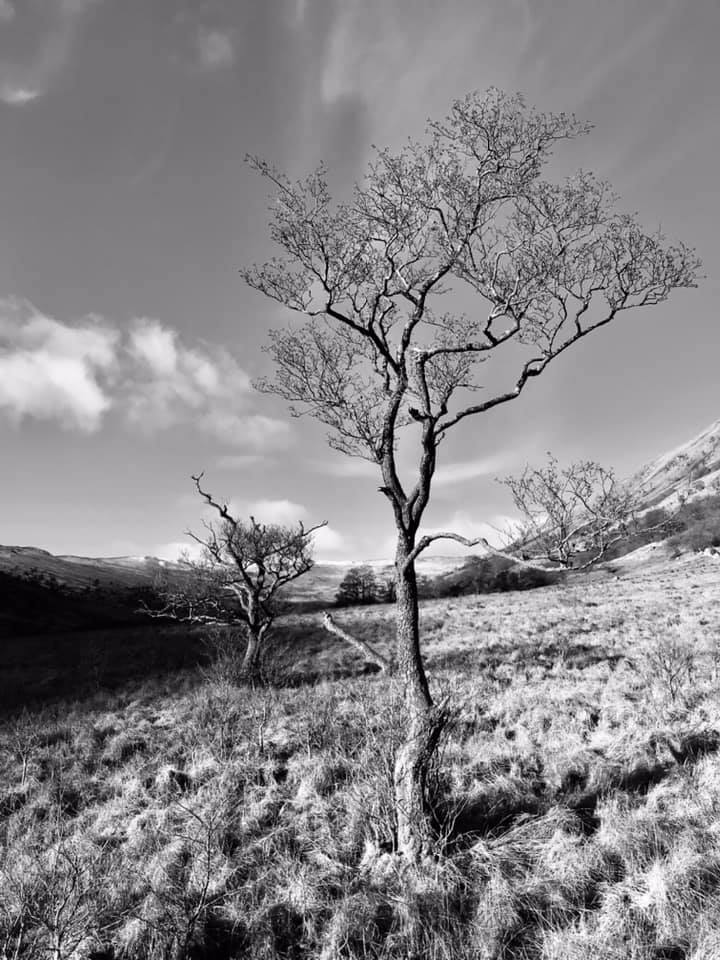
Photo by Siuna Mayes
Court of Session Record for John Bane Stewart, et al, vs Magaret, Dowager Countess of Moray, 1755-1772
John Bane Stewart and others, Lessees of Glen Finglas v. Margaret, Countess Dowager of Moray, and Frances, Earl of Moray
Submitted by the late Anne Danielson
Portioners of Glen Finglas, ca. 1820
We have a later portrait of the eight portioners of Glen Finglas, provided to us in Stewarts of the South, which was written ca. 1815-1820 and lists the eight portioners of Glen Finglas at that time. The only problem is that the document actually lists nine portioners for only eight properties:
- Alexander (Alasdair Mhor) Stewart in Auchnahaurd, son of James Stewart of Invercarnaig, son of John Ban Mor Stewart, Bains of Glenfinglas Family. (See below)
- John Stewart of the Grodich, son of John Stewart in Auchnahaird, son of John Ban Mor Stewart, Bains of Glenfinglas Family. (See below)
- Robert Ban Stewart in Auchnahard, son of John Ban Mor Stewart, Bains of Glenfinglas Family. (See below)
- Duncan Stewart in Auchnahard, son of John Ban Mor Stewart, Bains of Glenfinglas Family. (See below)
- John Stewart in Glenfinglas, (probably the upper western portion) son of Iain Dubh Stewart (Stewarts of the South Glenbuckie, III Branch, Line 4).
- John Stewart in Duart, son of Walter Stewart, 10th of Gartnafuaran.
- Robert Stewart in Duart, Gartnafuaran Family, IV Branch, Line 1
- Duncan Stewart in Duart, (see Appin-Invernahyle family below)
- John Stewart in Wester Brig O’ Turk (Glenbuckie Branch I, son of Walter Stewart in Brig o’ Turk, below)
Stewarts of the South lists the following as “former” tenants in Glen Finglas
- James Stewart formerly Tenant in Glenfinglas, Glenbuckie, III Branch, Line 1
- Walter Stewart (nephew to the John Stewart, son of Iain Dubh, above) once Tacksman of one eighth of Glenfinglas left two sons – now cottagers [at] Duncragan [on] Sir Pat[rick] Murray’s estate [in] Callander parish, bought from [the Earl of] Perth family. (Stewarts of the South Glenbuckie, III Branch, Line 4)
- Walter STEWART, in Brig o’ Turk b: ABT 1740 in Brig o’ Turk, Kilmadock, Perthshire, Scotland, great-grandson of Duncan Stewart, 8th of Glenbuckie. Formerly held one of the eight portions of Glenfinglas, but was forfeited for cutting down a tree without permission. Father of John Stewart in Wester Brig o’ Turk, above)
Emigration began to play a significant role in the 19th century and after 1820 many of these families left the Glen. According to The Stewarts of Ardvorlich Book 3, by the mid-19th century almost all of these families had immigrated to Canada.
A later obituary for James Stewart of Duart who died in 1895 gives us a wonderful portrait of the relationships between the various branches of Stewarts residing in Glenfinglas:
Glenfinglas was held jointly by six tenants (sic) — all Stewarts of course — each of them having his own farmhouse and steading, with a separate allotment of arable ground, on which he grazed his own cows and raised his own crops; while the hill pasture, the most important part of the holding, was held by the whole six in common, the stock of sheep thereon, numbering 8000 or more, being mutual property. Two of the tenants were annually elected managers to attend to the sales of sheep and the buying in of fresh breeding stock for the year; and while it might have been supposed that disagreements would have occurred occasionally, this was not the case, for the system had, through generations of practice, been brought to perfection, and the utmost harmony and good fellowship prevailed among the tenants from the earliest recorded time. When any question arose as to which tenant was to do any particular piece of work for the general good, or on any other point, the matter was invariably settled, and satisfactorily, by casting lots.
For a period of certainly more than two hundred years this little colony, or community, of Stewarts quietly pursued the even tenor of their ways — a shrewd, industrious, exemplary set of people, little troubled with the tumults and on-goings in the outside world.
The risings of 1715 and 1745 passed by without affecting them in any way, as, true and staunch to their chief and landlord, the Earl of Moray, they obeyed his wishes and took no part in these events….*
With one exception, the Stewarts were all adherents of the Established Church, although in the early part of last century all the inhabitants of Glenfinglass were Episcopalian; and they were, without exception, Conservative in politics.
* This is absolute polyanna fiction on the part of James Stewart of Duart. There are several documented cases of residents of Glen Finglas who were Jacobites, especially David Stewart, one of the lead tenants in the Glen Affair, who had to flee to France to avoid capture.
Portioners of Glen Finglas and their Neighbours, 1867
Slater’s Directory of Scotland, 1867 edition, provides us with a later profile of the residents of Glen Finglas as well as their neighbours in 1867. (This information was provided by Calander Heritage Society.)
From Slater’s Directory of Scotland 1867 Edition.
The Bridge of Turk is a small hamlet in this parish (Callander) and contains a school and the ruins of a very large and handsome hotel which was unfortunately burned down a short time ago.
Gentry and Clergy –
-
- John McGregor, Glangyle. [Glengyle]
- Stewart McNaughton, Invertrossachs.
- Rev. William Monteath, Trossachs.
Society;
-
- Schools – *Alexr, Stewart.
- Blacksmiths – John McGregor.
- Vintners – Catherine Ferguson.
- Boot & Shoe Makers – Robert Campbell.
- Tailors – Duncan McGregor.
Farmers (Callander) –
-
- Donald McFarlane, Coillachray.
- G.H.Marshall, Gartchonzie.
- John Stewart, Bochastle
Farmers (Trossachs) –
-
- Donald McFarlane, Achray.
- *Alexr. Stewart, Achnahard.
- *Charles Stewart, Glenfinlas. [a.k.a. Grodich]
- James Stewart, Edralachdach.
- *John Stewart, Duart.
- John Stewart, Lendrick.
- Robert Stewart, Culragreine. [Culnagraine]
- Duncan McFarlane, Portnella. [Portnellan]
- *Alexr. Stewart, junr. Achnahard.
- Duncan Stewart, Stroan.
- *James Stewart, Duart.
- *John Stewart, Achnahard.
- R.& D. Stewart, Letter.
* Portioners of Glen Finglas
Brig o Turk –
(left to right) Rose Cottage, Clan MacAlpine Cottage, White Cottage (later
known as Tea Room)
The Principal Stewart Families in Glen Finglas
We have seen from above that the key Stewart families residing in Glenfinglas (and present research would suggest that they were the only Stewarts in Glenfinglas) were cadet branches of all four of the principal families of Clan Stewart of Balquhidder and one branch of Clan Stewart of Appin:
-
- Stewarts of Ardvorlich
- Stewarts of Glenbucke
- Stewarts of Gartnafuaran
- Stewarts of Annat
- Stewarts of Invernahyle (Clan Stewart of Appin)
By 1875 social conditions had changed dramatically and Glenfinglas was nearly empty of inhabitants. The last of the Stewarts to reside in Glenfinglas was James Stewart of Duart (b. 1813), a bachelor who died in 1895 in a much mourned and lauded manner. On his father’s side he was descended from the Invernahyle Stewarts, but both his mother and grandmother were Bain Stewarts of the Annat family. With his passing the Stewarts of Glenfinglas were no more.
List of Early Stewarts in Glen Finglas, 1575-1700
The following records identify the earliest Stewarts residing in Glen Finglas.
- 15 Aug 1575 – James Stewart in the Glen mentioned in a retour for his relative James Stewart, son of the late Walter Stewart of Ballindorane. Also mentioned is Gregor Neilsoun “there” (Glen)
- 14 Dec 1592 – Duncan M’Alister Stewart in McGlenfinglas (eldest son of Alexander Stewart, 4th of Glenbuckie) cited in a complaint by Johnne Elphinstoun, for the Dryman Raid, along with Johnne McInteir in Grotik (John McIntyre in Grodich), Duncan Mcinteir in Glenfinlas, Johnne McKeith there, Patrick Mcquhirriman, Johnne Roy McRobert (McGregor from Clan Dugal Ciar), Duncan McAllaster Steuart in Mcglenfinlas, ( ), Robert Steuart Mcallaster, Johne Dow, his brother, James Mcallaster Steuart, ( ), John Dow Mcpatrick, his son.
- The late John Stewart of Ardvorlich, in The Stewarts of Ardvorlich, incorrectly identified this Duncan Mcallaster Steuart as being the son of Alexander Stewart, 1st of Ardvorlich, however Duncan, younger of Ardvorlich, wasn’t even born in 1592.
- This complaint identifies Duncan McAllester, Robert McAllester, John Dubh McAllester (brother of Robert), and James McAllester. It is likely that all four of these are brothers. Also listed is an unreadable entry followed by “John Dow McPatrick, his son,” suggesting that the unreadable entry was Patrick, likely Stewart. We know that Alexander Dubh Stewart, 4th of Glenbuckie, had sons named Duncan (who later became Forester of Glen Finglas), Robert, John Dubh, James and Patrick (latterly of Ledcreich), who would all be the right age.
- Alasdair Dubh nan Damh Stewart, drover from the Stewarts of Invernahyle, was likely also in Glen Finglas about this time, so could also be a contender, but the fact that the five sons’ names all line up perfectly with Alexander Dubh Stewart of Glenbuckie, makes it nearly certain to be him.
- 14 Jul 1613 – in a list of persons cited as guilty in the reset of Clan Gregor: Neill Stewart in Grodich (possibly Neil MacGregor-alias-Stewart, related to Gregor Neilsoun, above), Alexander Stewart in Dowart (probably Alasdair Dubh nan Damh Stewart of the Invernahyle family)
- 1620, 6th July, RPC vol. XII, p.317 – Commissioned by Lord Hay with Johnne Stewart in Portre (possibly John Stewart in Portnellan, but he would have been 80 years old) and Johnne and Alexander Stewart in Glenfinglas to apprehend and try Johnne Roy McDuff in Rannache for stealing under cloud and silence of night 4ky and ane meir pertaining to Donald McEanlay (McKinley) in Dulater.
- 1620 – (possibly the same reference as above) Alexander Stewart in Glenfinglas (possibly of the Invernahyle family, ancestor to the later Stewarts in Duart)
- 1623 – Alexander S. alias M’ean. John, Archibald, and Andrew, his sons. Walter M’eandowie alias Stewart (Alexander mac Iain Stewart, (latterly) 1st of Annat, and his sons, John Stewart, future 2nd of Annat, Archibald Stewart, ancestor of Glassingall, Andrew Stewart, latterly in Ardcheanochdan, and Walter Mceandowie Stewart, in Glenfinglas.)
- 1639 John, Alaster, and Walter Stewarts in Glen. Vol. III p.48, tenants to the Earl of Moray
- 1644 Walter S. in Glenfinglas Vol. 1 p.78
- Montrose was delighted to have this addition to his strength. Among those following James Stewart were many of his friends, relatives and retainers. Those whose names have come down were his sons, Robert and Harie; his cousins, Duncan McRobert Stewart and Andrew Stewart from Balquhidder and Walter Stewart from Glenfinglas; and John McGruther in Glasinserd, his relation both through his mother and through the marriage of his daughter to a McGruther. (1)
- Walter Dubh Mor Stewart in Glenfinglas, eldest son of Alexander Stewart, 5th of Gartnafuaran. He and his sons died in 1645 at the Battle of Kilsyth.
- Montrose was delighted to have this addition to his strength. Among those following James Stewart were many of his friends, relatives and retainers. Those whose names have come down were his sons, Robert and Harie; his cousins, Duncan McRobert Stewart and Andrew Stewart from Balquhidder and Walter Stewart from Glenfinglas; and John McGruther in Glasinserd, his relation both through his mother and through the marriage of his daughter to a McGruther. (1)
- 1645 Walter S. in Glenfinglas Vol. 1. p.147
- 9 Apr 1645, Bond of Keltnie Burn. Walter Stewart in Grodich.
- 1663 John S. in Glenfinglas Test[ament] (Auchnahard), James S., his lawful son. Another James S. married his daughter. Another daughter married Walter S. in Auchinferron (Gartnafueran?) — DCR [Dunblane Commissariat Records]
- 1665 Patrick S. in Grodich in Glenfinglas d.1664, Agnes S. spouse to Patrick S. in Grodich DCR lawful son John S. (minor), Duncan S. in Glenfinglas cautioner.
- 1665 Duncan S. Duart Glenfinglas – wife Janet S. d. Dec 1665 SGL
- 1675 Duncan S. Duart wife Jannet S. (Duart) d. Apr 1675 SGL (contradicts preceding)
- 1679, Register of Deeds. Bond. James Stewart in Dowart in Glenfinglas.
- 1679 James S. in Dowart in Glenfinglas Vol. III. p.48
- Register of Deeds. Bond. James Stewart in Dowart in Glenfinglas.
- 1680 Janet S. Duratt Par. of Callander DCR
- 1707 first mention of Auchnahard
The Ardvorlich Stewarts in Glenfinglas
The Ardvorlich portion of Glen Finglas seems to have been consistently occupied by descendants of the Stewarts of Annat. With the small exceptions noted here, no Ardvorlich family is shown as ever residing in Glen Finglas.
Maj. David Stewart, son of James Stewart, 4th of Ardvorlich, was appointed Forester in Glen Finglas sometime before 1745, but he likely never lived in Glen Finglas. (See Stewarts of Ardvorlich)
John Stewart in Duart was briefly in Glen Finglas in the late 1700s, but later moved to the Moss. (See Flint Stewarts in Lednascriddan, Stewarts of Ardvorlich Branch VI, Line 6)
The Stewarts in Auchrigg (Ardvorlich Branch III)
The following family from Stewarts of the South is listed as being a tenant in Grodich in Glen Finglas. This family has not been identified in records.
Donald Dubh Stewart in Grodich
-
-
-
- James Stewart, the lineal branch son to Donald Dubh, late tacksman of Grodich, Glenfinglas, was a tacksman of Monbreachy, port parish, [which is the] Duke of Montrose’s estate, Ld (Lordship) of Monteith – rent £250. He has four sons:
- Donald, who is a wright in Callander and has three sons who are all minors.
- Alexander, who is a tacksman of Auchyle, Port parish. He has four sons who are all minors. Rent £60
- Archibald, who is a cow feeder in Glasgow. He has three sons who are all minors.
- Charles, a natural son, is a sawyer in Callendar. He has four sons who are all minors. He is the most active of this family.
- James Stewart, the lineal branch son to Donald Dubh, late tacksman of Grodich, Glenfinglas, was a tacksman of Monbreachy, port parish, [which is the] Duke of Montrose’s estate, Ld (Lordship) of Monteith – rent £250. He has four sons:
-
-
The above James was a very sensible man and imparted but little of it to his family except to the natural son.
More information on this family can be found on our Stewarts in Auchraig (Ardvorlich Branch III) page.
The Glenbuckie Stewarts in Glenfinglas
The earliest Stewarts recorded as living in Glen Finglas were from the Stewarts of Glenbuckie. This should not be a surprise as Glenbuckie is just 3 km (2 miles) north of Glen Finglas. They shared shieling lands and an old drover’s road connected the two glens.
Stewarts of Glenbuckie Branch I
More information on this family can be found on our Stewarts of Glenbuckie page.
Alexander Stewart, 4th of Glenbuckie, had two sons who were in Glen Finglas by 1575
-
-
- Duncan McAllister Stewart, in McGlenfinglas, Deputy Royal Forester in Glen Finglas, latterly 5th of Glenbuckie. He was appointed Deputy Royal Forester in Glen Finglas about 1580. He participated in the Dryman Cattle Raid in 1592, where his is identified as Duncan McAllister Stewart in McGlenfinglas. His second wife was a MacGregor of Clan Dougal Ciar. Among his children was:
- John Dubh Beag Stewart in Muirlaggan, who is said to have assisted his cousin/brother-in-law, James Beag Stewart of Ardvorlich in the legend of the Clearing of Glen Finglas. He resided in Muirlaggan in Balquhidder. He never resided in Glen Finglas.
- James Stewart in Glen. The Stewarts of Ardvorlich, Book III, indicates that “the first person of the name of Stewart actually settled in Glenfinglas, was James Stewart in Glen, who is mentioned in 1575 in the special Retour of James Stewart of Baldofran (Baldorran)….” The most likely candidate for this James would be James Stewart, son of Alexander Stewart, 4th of Glenbuckie, who is believed to have had no children.
- Duncan McAllister Stewart, in McGlenfinglas, Deputy Royal Forester in Glen Finglas, latterly 5th of Glenbuckie. He was appointed Deputy Royal Forester in Glen Finglas about 1580. He participated in the Dryman Cattle Raid in 1592, where his is identified as Duncan McAllister Stewart in McGlenfinglas. His second wife was a MacGregor of Clan Dougal Ciar. Among his children was:
-
The Ardcheanochdan Family (Stewarts of Glenbuckie Branch III)
Stewarts of the South records a John Stewart, tacksman in Duart who had three sons. Their family has not been identified in records.
This family belonged to Branch III of the Stewarts of Glenbuckie and can be found on our Stewarts in Ardcheanochdan and Duart page, Line 3.
Stewarts in Brig O’ Turk
Lt. Walter Stewart in Wester Brig o’ Turk, son of Duncan Stewart, 8th of Glenbuckie. He had 1/8th of Glen Finglas.
-
-
- John Stewart, 2nd in Brig o’ Turk. John Stewart was a tacksman at Brig o’ Turk and one of the eight portioners of Glenfinglas who was involved in “The Glen Affair” in 1755
- Walter Stewart, 3rd in Brig o’ Turk. He was named in the Glen Affair appeal as succeeding his late father.
- John Stewart, 2nd in Brig o’ Turk. John Stewart was a tacksman at Brig o’ Turk and one of the eight portioners of Glenfinglas who was involved in “The Glen Affair” in 1755
-
This family is presented on the Stewarts of Glenbuckie page.
Stewarts in Duart
Duncan Stewart in Duart and Coirchrombie is described in Stewarts of the South as being deceased in 1820 and having had “a numerous family, none of which survived him except two sons of three marriages.” Duncan has not been identified in any public records. He can be found on the Stewarts of Glenbuckie Branch VII: The Gaelic Bible Stewarts in Killin page, Line 1.
The Gartnafuaran Stewarts in Glenfinglas
Stewarts of Gartnafuaran Branch 1
Donald Stewart in Duart and Auchnahard. Donald Stewart, believed to be son of James Stewart, 9th of Gartnafuaran. He married a MacNab of Braeleny, a branch known as “the French MacNabs” because of their time in France. He is believed to be the Donald Stewart listed among the tenants in the Glen Affair.
-
-
- Walter Frangich Stewart in Auchnahard, born 8 May 1777 in Auchnahard, Callander, Perthshire, Scotland. His nickname “Frangich” means “French speaker,” likely so-named after his mother. He married Elizabeth Robertson and had a family including the following. They moved in 1820 to Aberdeen.
- Daniel Stewart, b 14 Mar 1807 in Auchnahard, Glenfinglas, Callander, Perthshire, Scotland.
- Charles Stewart, b 3 Nov 1809 in Auchnahard, Glenfinglas, Callander, Perthshire, Scotland.
- Walter Frangich Stewart in Auchnahard, born 8 May 1777 in Auchnahard, Callander, Perthshire, Scotland. His nickname “Frangich” means “French speaker,” likely so-named after his mother. He married Elizabeth Robertson and had a family including the following. They moved in 1820 to Aberdeen.
-
Walter Stewart, 10th and last of Gartnafuaran. All of his children were born in Duart in the 1750s.
More information on these families can be found on our Stewarts of Gartnafuaran page.
From Stewarts of the South II Branch, Stiubhartic a Bhaid
James mor Stewart, formerly [a] tenant [in] Grodich [in] Glenfinglas, [who] moved [from there] to Monavrechie [in] Port [of Menteith] parish. [He was] a famous hardy soldier, who left three sons [namely]
-
-
- Alexander, [a] cottar to the present Alex Stewart, tacksman of Leanchoille [in] Port [of Menteith] Parish, who has no family
- James, his brother, [is] a founder in Glasgow [and] has three sons
- Walter, [who is] a tailor in Glasgow, [and] who has two sons under age.
-
More information on this family can be found on our Stewarts in Blairgarry page.
Gartnafuaran IV Branch Sean Rob [mhic] Alasdair Oig in Lower Duart and Grodich, Glen Finglas
Robert Stewart, 5th in Lower Duart, descended from Sean Rob “one of the eight tenants of the name of Stewart”, b 1733. He had 19 children by two wives.
More information on this family can be found on our Stewarts in Lower Duart page.
From V Branch Stewarts of Glenogle
James Stewart, 1st of Stank and Liannach and 1/4 of Glen Finglas, b abt 1710, is recorded in Stewarts of the South as a “tacksman of Stank and Leaniuch (Liannach) in Glenbuckie, and [also had] a fourth part of Glenfinglas.” However OPR information on the Stank family appears to indicate that none of the Stank Stewarts ever resided in Glenfinglas. It would appear that James merely held the tack of 1/4 of Glenfinglas and received the rentals thereof while residing in Stank in Strathyre. Since this family likely never resided in Glen Finglas they are presented on the Stewarts of Glenogle page. Despite having seven children, only one of them survived to adulthood. His only heir was his son James. Thus they match the description of the tenant in the Glen Affiar identified as “James Stewart and his only son and heir, James Stewart.”
-
-
- James Stewart, 2nd of Stank, b 1753.
-
The Annat Stewarts in Glenfinglas
The Bains of Glenfinglas – The Auchnahard Family
The Stewarts of Annat were the primary occupants of the Ardvorlich portion of Glen Finglas. They were a prolific family who married into all the other Glen Finglas Stewart families. A partial tree is presented heres:
Alexander mac Iain Dubh Stewart, 1st of Annat, referred to in “1623 – Alexander S. alias M’ean. John, Archibald, and Andrew, his sons. Walter M’eandowie alias Stewart (Alexander mac Iain Stewart, (latterly) 1st of Annat, and his sons, John Stewart, future 2nd of Annat, Archibald Stewart, ancestor of Glassingall, Andrew Stewart, latterly in Ardcheanochdan, and Walter Mceandowie Stewart, in Glenfinglas.)”
-
-
- Capt. John Stewart, 2nd of Annat
- Alexander Stewart, 3rd of Annat
- John Buidhe More Stewart in Glenfinglas, b abt 1625
- James Stewart in Auchanahard, b abt 1660
- John Ban Mor Stewart in Auchnahard. b 1711. He is the founder of the Bain Stewarts in Glen Finglas.
- James Stewart in Auchnahard, b. 1736
- John Stewart in Auchnahard, b. 1740
- Robert Ban Stewart in Auchnahard, b. 1747
- Duncan Stewart in Auchnahard, b. 1756
- (Other children)
- John Ban Mor Stewart in Auchnahard. b 1711. He is the founder of the Bain Stewarts in Glen Finglas.
- James Stewart in Auchanahard, b abt 1660
- (Other children)
- Walter Mceandowie Stewart in Glen Finglas
- Andrew Stewart in Glen Finglas and latterly in Ardcheanochdan
- James Stewart
- Archibald Stewart in Glen Finglas (ancestor to the later Stewarts of Glassingall)
- Capt. John Stewart, 2nd of Annat
-
Much more information can be found on this vast family on our Bain Stewarts in Auchnahard page.
The Invernahyle Stewarts in Glen Finglas (Clan Stewart of Appin) in Upper Duart
The Stewarts of Invernahyle were not related to the Stewarts of Balquhidder in the male line. The Stewarts of Invernahyle arrive late 1600s in Glen Finglas where they appear to have shared half of the Glenbuckie portion of the Glen. It is believed that an early member of this family may have married to the daughter of a Stewart of Glenbuckie. Otherwise it is difficult to understand how they ended up sharing one of the eight portions of Glen Finglas. However, no such marriage has so far been found.
Both Line 1 & 2 descend from Duncan mac Allan Stewarts who are about the same age. It is presumed but not confirmed that they are the same Duncan mac Allan Stewart. It’s possible that Lines 1&2 could descend from separate Duncan mac Allan Stewarts.
Allan Stewart, 2nd of Innischaoraich. b. abt. 1630. (Allan had an uncle Neil Stewart who would be the right age to be the early Neil Stewart in Glen Finglas.)
-
-
- Duncan mac Allan Stewart, Innkeeper at Tighnaluib, b. ABT 1660 at Innischaoraich, Glenlochy, Breadalbane, Perthshire, Scotland.
- LINE 1 – Allan Stewart in Doune, b abt 1690. m. daughter of Stewart of Drumvaich (Annat)
- Robert Stewart in Doune, b 1736
- LINE 2- Alastair Dubh nan Damh Stewart in Glen Finglas, b abt 1705
- Descendants unaccounted for
- LINE 2 – Robert Stewart in Duart, b 1709. m Mary Stewart of unknown
- Unknown Stewart in Duart, b abt 1740
- Duncan Stewart in Duart and Little Dulater, b abt 1770. His family ended up in Ardcheanochdan
- James D Stewart, b 1807 (went to Quebec, Canada)
- Duncan Stewart in Duart and Little Dulater, b abt 1770. His family ended up in Ardcheanochdan
- James Stewart in Duart, b 1744. m. Mary Stewart, dtr of John Ban Mor Stewart in Auchnahard (Annat family). 7 children including:
- John Stewart, no children
- Duncan Stewart in Duart, b 1786. m Christian Stewart in Auchnahard, dtr of Duncan Stewart in Auchnahard and Upper Duart
- James Stewart in Duart (the last Stewart in Glen Finglas, 1813-1895)
- Unknown Stewart in Duart, b abt 1740
- Donald Stewart in Duart, b abt 1712
- LINE 1 – Allan Stewart in Doune, b abt 1690. m. daughter of Stewart of Drumvaich (Annat)
- Duncan mac Allan Stewart, Innkeeper at Tighnaluib, b. ABT 1660 at Innischaoraich, Glenlochy, Breadalbane, Perthshire, Scotland.
-
More information about this family can be found on our Stewarts of Invernahyle page.
This brings to an end our story of how the Stewarts came to dominate Glen Finglas for three centuries. For more detailed information on the individual families who resided in Glen Finglas, please go to their detailed family history pages:
Stewarts of Ardvorlich (Annat)
Stewarts of Glenbuckie
Stewarts of Gartnafuaran
Stewarts of Invernahyle (Appin)
Sources
Sources
In our research, we cite many documentary sources. Some of the most common ones that you will find referenced and abbreviated in our notes include:
- Duncan Stewart (1739). A Short Historical and Genealogical Account of the Surname Stewart…. (It’s actual title is much longer), by Rev. Duncan Stewart, M.A., 1st of Strathgarry and Innerhadden, son of Donald Stewart, 5th of Invernahyle, published in 1739. Public domain.
- Stewarts of the South. A large collection of letters written circa 1818-1820 by Capt. James Stewart, factor (estate manager) to Maj. Gen. David Stewart of Garth, comprising a near complete inventory of all Stewart families living in southern Perthshire, including all branches of the Stewarts of Balquhidder.
- MacGregor, Gordon, The Red Book of Scotland. 2020 (http://redbookofscotland.co.uk/, used with permission). Gordon MacGregor is one of Scotland’s premier professional family history researchers who has conducted commissioned research on behalf of the Lord Lyon Court. He has produced a nine volume encyclopedic collection of the genealogies of all of Scotland’s landed families with meticulous primary source references. Gordon has worked privately with our research team for over 20 years.
- The Stewarts of Ardvorlich, Books 1-3, and Supplement. Privately published. The originals are housed at the Stewart Society Archives in Edinburgh, Scotland. Digitized by the Stewarts of Balquhidder Research Group in 2023 with permission from Sandy Stewart, 15th of Ardvorlich (26 June 2023). Copyright of these books remains with the family of the Stewarts of Ardvorlich with permission granted only to the Stewart Society and the Stewarts of Balquhidder Research Group to publish the full digital versions on their respective websites. The digital versions may not be reproduced, republished, or reposted on any other websites without permission from the family of the Stewarts of Ardvorlich.
- The Stewarts of Ardvorlich Vol. 1, ©1946 by John Stewart of Ardvorlich, Ardvorlich, Perthshire, Scotland, self-published, bound by L. Dopierala, Perth, Perthshire, Scotland.
- The Stewarts of Ardvorlich Vol. 2, ©1968 by John Stewart of Ardvorlich, Ardvorlich, Perthshire, Scotland, self-published, bound by L. Dopierala, Perth, Perthshire, Scotland.
- The Stewarts of Ardvorlich Vol. 3, ©1975 by John Stewart of Ardvorlich, Ardvorlich, Perthshire, Scotland, self-published, bound by L. Dopierala, Perth, Perthshire, Scotland.
- The Stewarts of Ardvorlich – Supplement, ©1985 by John Stewart of Ardvorlich, Ardvorlich, Perthshire, Scotland, self-published.
- [Parish Name] OPR. This refers to various Old Parish Registers.
- For a full list of sources, click here.
Additional Sources:
- Buchanan of Auchmar history (1723)
- Personal correspondence with professional researcher Gordon MacGregor, author of “The Red Book of Scotland“
- Various estate records and testaments too numerous to list here.

